-
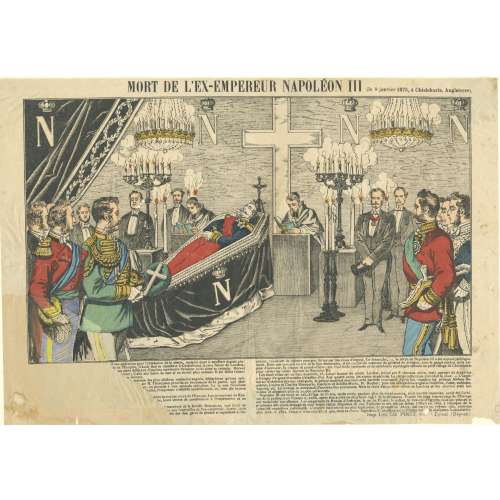 Hand-coloured woodcut on wove paper, 270 x 380 mm; attached to the sheet 303 x 442 mm with pencil ms inscription to the top left corner on the reverse: “Haye le 2-3-75”. Top: "MORT DE L'EX-EMPEREUR NAPOLÉON III (le 9 janvier 1873, à Chislehurts [sic], Angleterre)." Bottom right: "Imp. Lith. CH. PINOT, éditeur. Épinal (Dépose)". Bottom left corner of the image sheet torn and manually restored. Text partially lost, starting with « d’une opération pour l’extraction de la pierre, maladie dont’ il souffrait depuis plu-… ». See Chislehurst. Charles-François Pinot (French, 1817 – 1879) – publisher/printer.
Hand-coloured woodcut on wove paper, 270 x 380 mm; attached to the sheet 303 x 442 mm with pencil ms inscription to the top left corner on the reverse: “Haye le 2-3-75”. Top: "MORT DE L'EX-EMPEREUR NAPOLÉON III (le 9 janvier 1873, à Chislehurts [sic], Angleterre)." Bottom right: "Imp. Lith. CH. PINOT, éditeur. Épinal (Dépose)". Bottom left corner of the image sheet torn and manually restored. Text partially lost, starting with « d’une opération pour l’extraction de la pierre, maladie dont’ il souffrait depuis plu-… ». See Chislehurst. Charles-François Pinot (French, 1817 – 1879) – publisher/printer. -
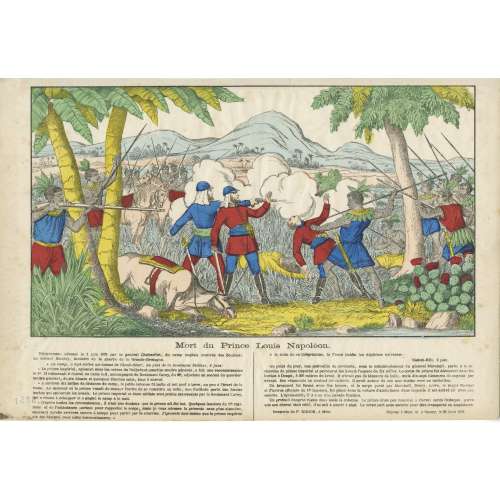 Hand-coloured woodcut on wove paper, 267 x 390 mm. On reverse: black ink stamp “5351”. Centre, under the image frame "Mort du Prince Louis Napoléon". Below left: "Télégramme adressé le 2 juin 1879 par le général Chelmsfort, du camp anglais (contrée des Zoulous), au colonel Stanley, ministre de la guerre de la Grande-Bretagne. « Au camp, à sept milles au-dessus de Blood-River, au pied de la montagne Stellezi, 2 juin: Le prince impérial, agissant sous les ordres de l'adjudant quartier-maitre général. a fait une reconnaissance le 1er. Il retournait à cheval au camp le 2 accompagné du lieutenant Carey, du 98e adjudant en second du quartier-maitre général. de six blancs et, quelques Zoulous amis, tous à cheval. A environ dix milles de distance du camp, la petite colonne fit halte at mit pied à terre, un peu à l’écart de la route. Au moment ou le prince venait de donner l'ordre de se remettre en selle. une fusillade partit des hautes herbes qui entourant les kraals. Le prince impérial et deux soldats sont portés manquants par le lieutenant Carey, qui a réussi à échapper et a gagné le camp à la nuit. D'après toutes les circonstances, il 'est pas douteux quo le prince ait été tué. Quelques lanciers du 17 régiment et de l'ambulance partent pour rapporter le corps; mais je vous adresse la présente sans plus attendre, espérant qu'elle arrivera encore à temps pour partir par le courrier. J’ignorais moi-même que le prince impérial eût été désigné pour cette reconnaissance. »" Below right: A la suite de le télégramme, le Times publie les dépêches suivantes: Stelezi-Hill, 2 juin. Au point du jour, une patrouille de cavalerie, sous le commandement du général Marshall. partit à la recherche du prince impérial et parcourut les kraals l'espace de dix milles. Le corps du prince fut découvert dans les herbes à Donga, à 300 mètres du kraal. Il n'avait pas de blessure de balle, mais dix-sept blessures de zagaies par devant. Ses vêtements lui avaient été enlevés. I avait autour du cou une chaine avec un médaillon. Un brancard fut formé avec les lances, et le corps porté par Marchall, Drury, Lowe, le mjor Stewart et d'autres officiers du 17e lanciers, fut. place dans la voiture d'ambulance dans laquelle il est arrivé ici avec une escorte. L'après-midi, il v a eu une parade funèbre. Un profond chagrin règne dans toute la colonne. Le prince n'est pas remonté à cheval après l’attique, parce que son cheval était rétif ; il se mit à courir à pied. Le corps part sous escorte pour être transporté en Angleterre. Bottom right: "Imagerie de P. DIDION, à Metz — Déposé à Metz et à Nancy, le 25 Juin 1879". Paulin Didion (French, 1831 – 1879) – publisher/printer.
Hand-coloured woodcut on wove paper, 267 x 390 mm. On reverse: black ink stamp “5351”. Centre, under the image frame "Mort du Prince Louis Napoléon". Below left: "Télégramme adressé le 2 juin 1879 par le général Chelmsfort, du camp anglais (contrée des Zoulous), au colonel Stanley, ministre de la guerre de la Grande-Bretagne. « Au camp, à sept milles au-dessus de Blood-River, au pied de la montagne Stellezi, 2 juin: Le prince impérial, agissant sous les ordres de l'adjudant quartier-maitre général. a fait une reconnaissance le 1er. Il retournait à cheval au camp le 2 accompagné du lieutenant Carey, du 98e adjudant en second du quartier-maitre général. de six blancs et, quelques Zoulous amis, tous à cheval. A environ dix milles de distance du camp, la petite colonne fit halte at mit pied à terre, un peu à l’écart de la route. Au moment ou le prince venait de donner l'ordre de se remettre en selle. une fusillade partit des hautes herbes qui entourant les kraals. Le prince impérial et deux soldats sont portés manquants par le lieutenant Carey, qui a réussi à échapper et a gagné le camp à la nuit. D'après toutes les circonstances, il 'est pas douteux quo le prince ait été tué. Quelques lanciers du 17 régiment et de l'ambulance partent pour rapporter le corps; mais je vous adresse la présente sans plus attendre, espérant qu'elle arrivera encore à temps pour partir par le courrier. J’ignorais moi-même que le prince impérial eût été désigné pour cette reconnaissance. »" Below right: A la suite de le télégramme, le Times publie les dépêches suivantes: Stelezi-Hill, 2 juin. Au point du jour, une patrouille de cavalerie, sous le commandement du général Marshall. partit à la recherche du prince impérial et parcourut les kraals l'espace de dix milles. Le corps du prince fut découvert dans les herbes à Donga, à 300 mètres du kraal. Il n'avait pas de blessure de balle, mais dix-sept blessures de zagaies par devant. Ses vêtements lui avaient été enlevés. I avait autour du cou une chaine avec un médaillon. Un brancard fut formé avec les lances, et le corps porté par Marchall, Drury, Lowe, le mjor Stewart et d'autres officiers du 17e lanciers, fut. place dans la voiture d'ambulance dans laquelle il est arrivé ici avec une escorte. L'après-midi, il v a eu une parade funèbre. Un profond chagrin règne dans toute la colonne. Le prince n'est pas remonté à cheval après l’attique, parce que son cheval était rétif ; il se mit à courir à pied. Le corps part sous escorte pour être transporté en Angleterre. Bottom right: "Imagerie de P. DIDION, à Metz — Déposé à Metz et à Nancy, le 25 Juin 1879". Paulin Didion (French, 1831 – 1879) – publisher/printer. -
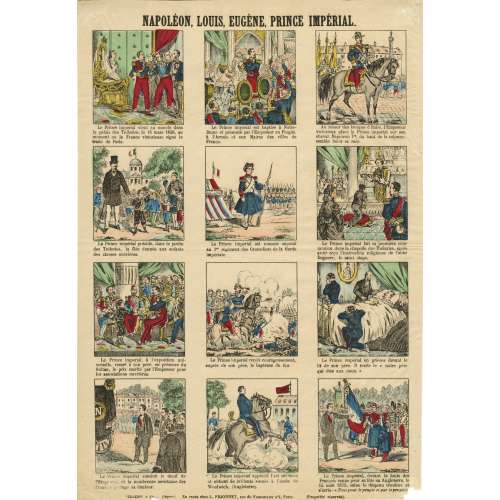 Hand-coloured woodcut on wove paper, 400 x 277 mm. Top: "NAPOLÉON, LOUIS, EUGÈNE, PRINCE IMPÉRIAL"; bellow 12 captioned frames:
Hand-coloured woodcut on wove paper, 400 x 277 mm. Top: "NAPOLÉON, LOUIS, EUGÈNE, PRINCE IMPÉRIAL"; bellow 12 captioned frames:- Le Prince impérial vient au monde dans le palais des Tuileries, le 16 mars 1856, au moment où la France victorieuse signe le traité de Paris.
- Le Prince impérial est baptisé à Notre-Dame et présenté par l'Empereur au Peuple, à l’Armée et aux Maires des villes de France.
- Au retour des troupes d'Italie, l'Empereur victorieux place le Prince impérial sur son cheval. Napoléon Ier, du haut de la colonne, semble bénir sa race.
- Le Prince impérial préside, dans le jardin des Tuileries, la fête donnée aux enfants des classes ouvrières.
- Le Prince impérial est nommé caporal au 1er régiment des Grenadiers de la Garde impériale.
- Le Prince impérial fait sa première communion dans la chapelle des Tuileries, après avoir reçu l'instruction religieuse de l'abbé Deguerry, le saint otage.
- Le Prince impérial, à l'exposition universelle, remet à son père. en présence du Sultan, le prix mérité par l'Empereur pour les associations ouvrières.
- Le Prince impérial reçoit courageusement, auprès de son père, le baptême du feu.
- Le Prince impérial en prières devant le lit de son père. Il récite le « notre père qui ètes aux cieux. »
- Le Prince impérial conduit le deuil de l'Empereur, et la nombreuse assistance des Français portage sa douleur.
- Le Prince impérial apprend l’art militaire et obtient de brillants succès à l'écolo de Woolwich, (Angleterre).
- Le Prince impérial, devant la foule des Français venus pour sa fête en Angleterre, le 15 out 1873, salue le drapeau tricolore et s'écrie : « Tout pour le peuple et par le peuple… »
-
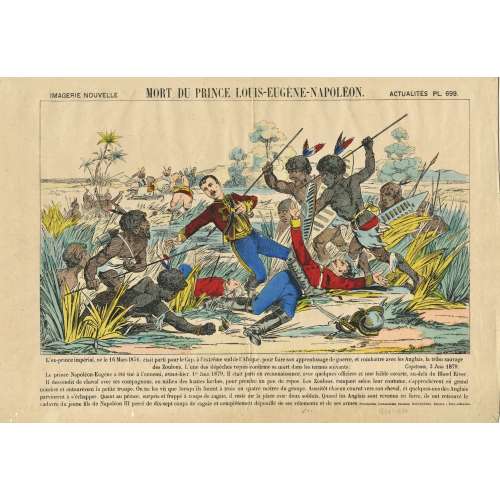 Hand-coloured lithography on wove paper, 275 x 385 mm; vertical centerfold, image in frame. On reverse: black ink stamp “5350”. Above the frame: "IMAGERIE NOUVELLE — MORT DU PRINCE LOUIS-EUGÈNE-NAPOLÉON. — ACTUALITÉS PL. 699". Under the frame: "L'ex-prince impérial, né le 16 Mars I856, était parti pour le Cap, à l'extrême sud de l'Afrique, pour faire son apprentissage de guerre, et combattre avec les Anglais, la tribu sauvage des Zoulous. L'une des dépêches reçues confirme sa mort dans les termes suivants: — Capetown, 3 Juin 1879. — Le prince Napoléon-Eugène a été tué à l'ennemi, avant-hier, 1er Juin 1879, Il était parti en reconnaissance, avec quelques officiers et une fable escorte, au-delà du Blood River. Il descendit de cheval ave ses compagnons, au milieu des hautes herbes, pour prendre un peu de repos. Les Zoulous, rampant selon leur coutume, s'approchèrent en grand nombre et entourèrent la petite troupe. On ne les vit que lorsqu' ils furent à trois ou quatre mètres du groupe. Aussitôt chacun court vers son cheval, et quelques-uns des Anglais parvinrent à s'échapper. Quant au prince, surpris et frappé à coups de zagaie, il resta sur la place avec deux soldats. Quand les Anglais sont revenus en force, ils ont retrouvé le cadavre du jeune fils de Napoléon III percé de dix-sept coups de zagaie et complétement dépouillé de ses vêtements et de ses armes". — "Typographie, Lithographie, Imagerie, Haguenthal, Éditeur à Pont-à-Mousson". Pencil ms: "1860-1880". Élie Haguenthal (French, 1822 – 1881) – publisher/printer.
Hand-coloured lithography on wove paper, 275 x 385 mm; vertical centerfold, image in frame. On reverse: black ink stamp “5350”. Above the frame: "IMAGERIE NOUVELLE — MORT DU PRINCE LOUIS-EUGÈNE-NAPOLÉON. — ACTUALITÉS PL. 699". Under the frame: "L'ex-prince impérial, né le 16 Mars I856, était parti pour le Cap, à l'extrême sud de l'Afrique, pour faire son apprentissage de guerre, et combattre avec les Anglais, la tribu sauvage des Zoulous. L'une des dépêches reçues confirme sa mort dans les termes suivants: — Capetown, 3 Juin 1879. — Le prince Napoléon-Eugène a été tué à l'ennemi, avant-hier, 1er Juin 1879, Il était parti en reconnaissance, avec quelques officiers et une fable escorte, au-delà du Blood River. Il descendit de cheval ave ses compagnons, au milieu des hautes herbes, pour prendre un peu de repos. Les Zoulous, rampant selon leur coutume, s'approchèrent en grand nombre et entourèrent la petite troupe. On ne les vit que lorsqu' ils furent à trois ou quatre mètres du groupe. Aussitôt chacun court vers son cheval, et quelques-uns des Anglais parvinrent à s'échapper. Quant au prince, surpris et frappé à coups de zagaie, il resta sur la place avec deux soldats. Quand les Anglais sont revenus en force, ils ont retrouvé le cadavre du jeune fils de Napoléon III percé de dix-sept coups de zagaie et complétement dépouillé de ses vêtements et de ses armes". — "Typographie, Lithographie, Imagerie, Haguenthal, Éditeur à Pont-à-Mousson". Pencil ms: "1860-1880". Élie Haguenthal (French, 1822 – 1881) – publisher/printer. -
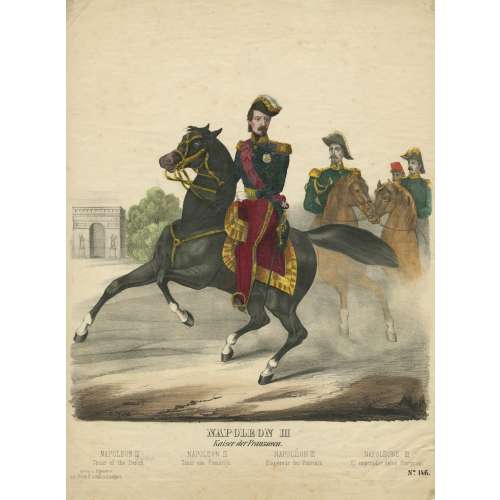 Hand-coloured lithography on wove paper 423 x 332 mm; On reverse: black ink stamp “4956”, ms “A”, ms pencil “428” and “Ernest”. Under the image, centre: "NAPOLEON III | Kaiser der Franzosen." Velow: | NAPOLEON III | Czaar of the French — NAPOLEON III | Czaar van Frankrijk — NAPOLÉON III | Empereur des Francais. — NAPOLEONE III | El emperador delos Franceses; bottom left: "Verlag u. Eigenthum | von. Fried. G. Schulz in Stuttgart.", right: "No 146." The artist's and printer's names in stone are not legible. Published in Stuttgart by Friederich Gustav Schulz (German, 1786 – 1859) during the time of the Second French Empire (1852-1870).
Hand-coloured lithography on wove paper 423 x 332 mm; On reverse: black ink stamp “4956”, ms “A”, ms pencil “428” and “Ernest”. Under the image, centre: "NAPOLEON III | Kaiser der Franzosen." Velow: | NAPOLEON III | Czaar of the French — NAPOLEON III | Czaar van Frankrijk — NAPOLÉON III | Empereur des Francais. — NAPOLEONE III | El emperador delos Franceses; bottom left: "Verlag u. Eigenthum | von. Fried. G. Schulz in Stuttgart.", right: "No 146." The artist's and printer's names in stone are not legible. Published in Stuttgart by Friederich Gustav Schulz (German, 1786 – 1859) during the time of the Second French Empire (1852-1870). -
 Colour (tone) lithography, image 396 x 508 mm, sheet 532 x 654 mm; before signature, undated; pencil ms inscription: Föhrenhain — E. Pelikan / 200M to the lower-right corner of the sheet. Contributor: Emilie Mediz-Pelikan (Austrian, 1861 – 1908) – artist. Seller's description: Austrian-German painter and graphic artist. Emilie Mediz-Pelikan was born in Vöcklabruck in 1861. She studied at the Vienna Academy and followed her teacher Albert Zimmermann to Salzburg and in 1885 to Munich. In 1891 she married the painter and graphic artist Karl Mediz (1868 - 1945), with whom she lived in Vienna and from 1894 in Dresden. She was in contact with the Dachau Artists' Colony and went on study trips to Paris, Belgium, Hungary and Italy. In the Dachau artists' colony she was friends with Adolf Hölzel and Fritz von Uhde. In 1889 and 1890 she spent time in Paris and in the Belgian artists' colony Knokke. In 1898 she was represented at the first art exhibition of the Vienna Secession, and in 1901 at the International Art Exhibition in Dresden. In 1903 she and her husband had a group exhibition, at the Hagenbund in Vienna. In 1904, she showed graphic works at the Dresden royal court art dealer Richter, and in 1905 and 1906 she exhibited at the Berlin Künstlerhaus. It was not until around 1900 that she achieved her artistic breakthrough with her landscape paintings. Since the estate of the artist, who died prematurely in Dresden in 1908, was lost in the former GDR until the 1980s, it was quite late that the artist was rediscovered and revalued both in Austrian art history and on the art market. In 1986, the first major exhibitions took place at the Upper Austrian State Museum and the University of Applied Arts in Vienna, followed by numerous smaller exhibitions in private galleries in Vienna, Linz and Munich. The artist received recognition during her lifetime from numerous prominent fellow painters as well as from the art critic Ludwig Hevesi. Together with Tina Blau, Herbert Boeckl, Marie Egner, Theodor von Hörmann, Franz Jaschke, Eugen Jettel, Ludwig Heinrich Jungnickel, Rudolf Junk, Gustav Klimt, Oskar Kokoschka, Johann Victor Krämer, Heinrich Kühn, Carl Moll, Rudolf Quittner, Rudolf Ribarz, Emil Jakob Schindler, Max Suppantschitsch, Max Weiler, Olga Wisinger-Florian and Alfred Zoff, she was a protagonist of the reception of Impressionism in Austria. This style went down in Austrian art history under the term "Stimmungsimpressionismus".
Colour (tone) lithography, image 396 x 508 mm, sheet 532 x 654 mm; before signature, undated; pencil ms inscription: Föhrenhain — E. Pelikan / 200M to the lower-right corner of the sheet. Contributor: Emilie Mediz-Pelikan (Austrian, 1861 – 1908) – artist. Seller's description: Austrian-German painter and graphic artist. Emilie Mediz-Pelikan was born in Vöcklabruck in 1861. She studied at the Vienna Academy and followed her teacher Albert Zimmermann to Salzburg and in 1885 to Munich. In 1891 she married the painter and graphic artist Karl Mediz (1868 - 1945), with whom she lived in Vienna and from 1894 in Dresden. She was in contact with the Dachau Artists' Colony and went on study trips to Paris, Belgium, Hungary and Italy. In the Dachau artists' colony she was friends with Adolf Hölzel and Fritz von Uhde. In 1889 and 1890 she spent time in Paris and in the Belgian artists' colony Knokke. In 1898 she was represented at the first art exhibition of the Vienna Secession, and in 1901 at the International Art Exhibition in Dresden. In 1903 she and her husband had a group exhibition, at the Hagenbund in Vienna. In 1904, she showed graphic works at the Dresden royal court art dealer Richter, and in 1905 and 1906 she exhibited at the Berlin Künstlerhaus. It was not until around 1900 that she achieved her artistic breakthrough with her landscape paintings. Since the estate of the artist, who died prematurely in Dresden in 1908, was lost in the former GDR until the 1980s, it was quite late that the artist was rediscovered and revalued both in Austrian art history and on the art market. In 1986, the first major exhibitions took place at the Upper Austrian State Museum and the University of Applied Arts in Vienna, followed by numerous smaller exhibitions in private galleries in Vienna, Linz and Munich. The artist received recognition during her lifetime from numerous prominent fellow painters as well as from the art critic Ludwig Hevesi. Together with Tina Blau, Herbert Boeckl, Marie Egner, Theodor von Hörmann, Franz Jaschke, Eugen Jettel, Ludwig Heinrich Jungnickel, Rudolf Junk, Gustav Klimt, Oskar Kokoschka, Johann Victor Krämer, Heinrich Kühn, Carl Moll, Rudolf Quittner, Rudolf Ribarz, Emil Jakob Schindler, Max Suppantschitsch, Max Weiler, Olga Wisinger-Florian and Alfred Zoff, she was a protagonist of the reception of Impressionism in Austria. This style went down in Austrian art history under the term "Stimmungsimpressionismus". -
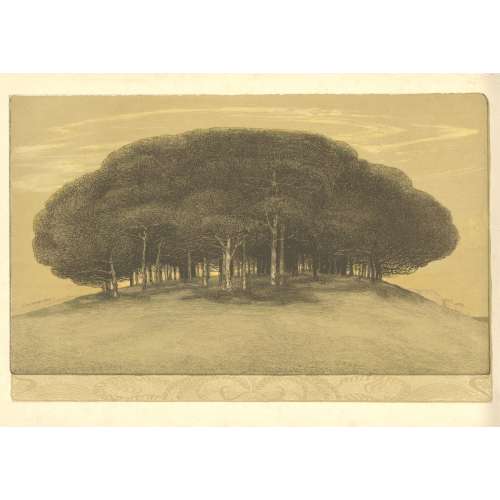 Colour (tone) lithography, image 268 x 410 mm, sheet 317 x 470 mm; signed on bottom-left of the image “Pelikan 1905”, and pencil ms inscription: E. Pelikan to the lower-right corner of the sheet. Contributor: Emilie Mediz-Pelikan (Austrian, 1861 – 1908) – artist. Seller's description: Austrian-German painter and graphic artist. Emilie Mediz-Pelikan was born in Vöcklabruck in 1861. She studied at the Vienna Academy and followed her teacher Albert Zimmermann to Salzburg and in 1885 to Munich. In 1891 she married the painter and graphic artist Karl Mediz (1868 - 1945), with whom she lived in Vienna and from 1894 in Dresden. She was in contact with the Dachau Artists' Colony and went on study trips to Paris, Belgium, Hungary and Italy. In the Dachau artists' colony she was friends with Adolf Hölzel and Fritz von Uhde. In 1889 and 1890 she spent time in Paris and in the Belgian artists' colony Knokke. In 1898 she was represented at the first art exhibition of the Vienna Secession, and in 1901 at the International Art Exhibition in Dresden. In 1903 she and her husband had a group exhibition, at the Hagenbund in Vienna. In 1904, she showed graphic works at the Dresden royal court art dealer Richter, and in 1905 and 1906 she exhibited at the Berlin Künstlerhaus. It was not until around 1900 that she achieved her artistic breakthrough with her landscape paintings. Since the estate of the artist, who died prematurely in Dresden in 1908, was lost in the former GDR until the 1980s, it was quite late that the artist was rediscovered and revalued both in Austrian art history and on the art market. In 1986, the first major exhibitions took place at the Upper Austrian State Museum and the University of Applied Arts in Vienna, followed by numerous smaller exhibitions in private galleries in Vienna, Linz and Munich. The artist received recognition during her lifetime from numerous prominent fellow painters as well as from the art critic Ludwig Hevesi. Together with Tina Blau, Herbert Boeckl, Marie Egner, Theodor von Hörmann, Franz Jaschke, Eugen Jettel, Ludwig Heinrich Jungnickel, Rudolf Junk, Gustav Klimt, Oskar Kokoschka, Johann Victor Krämer, Heinrich Kühn, Carl Moll, Rudolf Quittner, Rudolf Ribarz, Emil Jakob Schindler, Max Suppantschitsch, Max Weiler, Olga Wisinger-Florian and Alfred Zoff, she was a protagonist of the reception of Impressionism in Austria. This style went down in Austrian art history under the term "Stimmungsimpressionismus".
Colour (tone) lithography, image 268 x 410 mm, sheet 317 x 470 mm; signed on bottom-left of the image “Pelikan 1905”, and pencil ms inscription: E. Pelikan to the lower-right corner of the sheet. Contributor: Emilie Mediz-Pelikan (Austrian, 1861 – 1908) – artist. Seller's description: Austrian-German painter and graphic artist. Emilie Mediz-Pelikan was born in Vöcklabruck in 1861. She studied at the Vienna Academy and followed her teacher Albert Zimmermann to Salzburg and in 1885 to Munich. In 1891 she married the painter and graphic artist Karl Mediz (1868 - 1945), with whom she lived in Vienna and from 1894 in Dresden. She was in contact with the Dachau Artists' Colony and went on study trips to Paris, Belgium, Hungary and Italy. In the Dachau artists' colony she was friends with Adolf Hölzel and Fritz von Uhde. In 1889 and 1890 she spent time in Paris and in the Belgian artists' colony Knokke. In 1898 she was represented at the first art exhibition of the Vienna Secession, and in 1901 at the International Art Exhibition in Dresden. In 1903 she and her husband had a group exhibition, at the Hagenbund in Vienna. In 1904, she showed graphic works at the Dresden royal court art dealer Richter, and in 1905 and 1906 she exhibited at the Berlin Künstlerhaus. It was not until around 1900 that she achieved her artistic breakthrough with her landscape paintings. Since the estate of the artist, who died prematurely in Dresden in 1908, was lost in the former GDR until the 1980s, it was quite late that the artist was rediscovered and revalued both in Austrian art history and on the art market. In 1986, the first major exhibitions took place at the Upper Austrian State Museum and the University of Applied Arts in Vienna, followed by numerous smaller exhibitions in private galleries in Vienna, Linz and Munich. The artist received recognition during her lifetime from numerous prominent fellow painters as well as from the art critic Ludwig Hevesi. Together with Tina Blau, Herbert Boeckl, Marie Egner, Theodor von Hörmann, Franz Jaschke, Eugen Jettel, Ludwig Heinrich Jungnickel, Rudolf Junk, Gustav Klimt, Oskar Kokoschka, Johann Victor Krämer, Heinrich Kühn, Carl Moll, Rudolf Quittner, Rudolf Ribarz, Emil Jakob Schindler, Max Suppantschitsch, Max Weiler, Olga Wisinger-Florian and Alfred Zoff, she was a protagonist of the reception of Impressionism in Austria. This style went down in Austrian art history under the term "Stimmungsimpressionismus". -
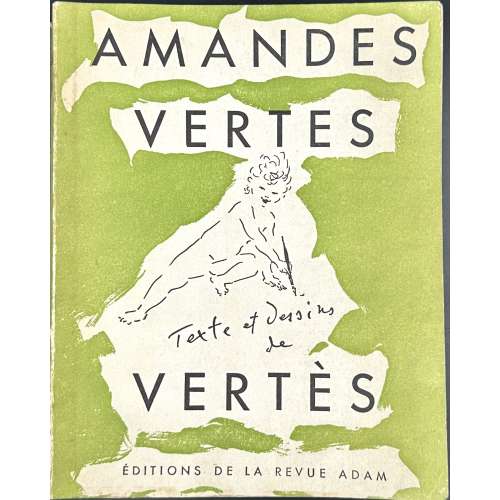 Paperback, 23.7 x 19 cm, green pictorial wrappers, lettering to spine, glassine dust jacket, some pages uncut, signed autograph blue ink inscription to h.t. "Au dr. Manuel Bruker en souvenir d'une harmonieuse collaboration. Vertès, 1952"; pp.[1-6] 7-489 [490] [2], profusely illustrated in b/w., Title-page: AMANDES VERTES | {vignette} | Texte et dessins | de | VERTÈS | ÉDITIONS REVUE ADAM | 4, RUE DE LA PAIX – PARIS – 2e || Limitation: Il a été tiré 200 exemplaires sur papier vélin d'arches; ceux-ci comportent un frontispice inédit en lithographie originale en 3 couleurs signée par l'auteur, tirée par Mourlot frères; ces exemplaires composent l'édition de luxe numérotée de 1 a 200. En plus, 20 exemplaires hors commence ont été réservés a des service personnels; ils sont numérotés de I a XX en chiffres romains. Ces deux éditions forment la totalité du tirage de luxe. Colophon: Achevé d'imprimer le 30 juin 1952 sur les presses de l'imprimerie Hérissey à Évreux numéro d'édition de l'éditeur : 91. Edition limited to 200 copies numbered 1 to 200 and 20 copies numbered from I to XX. This is copy № 91. No coloured frontispiece. Catalogue raisonné: Vokaer № 53. Provenance: Manuel Bruker (French, 1891 – 1979) Contributors: Marcel Vertès [Marcell Vértes] (Jewish-Hungarian-French, 1895 – 1961) – author/artist. Imprimerie Hérissey (Évreux) – printer. Edition Adam La Revue D' Homme [Revue Adam] – publisher.
Paperback, 23.7 x 19 cm, green pictorial wrappers, lettering to spine, glassine dust jacket, some pages uncut, signed autograph blue ink inscription to h.t. "Au dr. Manuel Bruker en souvenir d'une harmonieuse collaboration. Vertès, 1952"; pp.[1-6] 7-489 [490] [2], profusely illustrated in b/w., Title-page: AMANDES VERTES | {vignette} | Texte et dessins | de | VERTÈS | ÉDITIONS REVUE ADAM | 4, RUE DE LA PAIX – PARIS – 2e || Limitation: Il a été tiré 200 exemplaires sur papier vélin d'arches; ceux-ci comportent un frontispice inédit en lithographie originale en 3 couleurs signée par l'auteur, tirée par Mourlot frères; ces exemplaires composent l'édition de luxe numérotée de 1 a 200. En plus, 20 exemplaires hors commence ont été réservés a des service personnels; ils sont numérotés de I a XX en chiffres romains. Ces deux éditions forment la totalité du tirage de luxe. Colophon: Achevé d'imprimer le 30 juin 1952 sur les presses de l'imprimerie Hérissey à Évreux numéro d'édition de l'éditeur : 91. Edition limited to 200 copies numbered 1 to 200 and 20 copies numbered from I to XX. This is copy № 91. No coloured frontispiece. Catalogue raisonné: Vokaer № 53. Provenance: Manuel Bruker (French, 1891 – 1979) Contributors: Marcel Vertès [Marcell Vértes] (Jewish-Hungarian-French, 1895 – 1961) – author/artist. Imprimerie Hérissey (Évreux) – printer. Edition Adam La Revue D' Homme [Revue Adam] – publisher. -
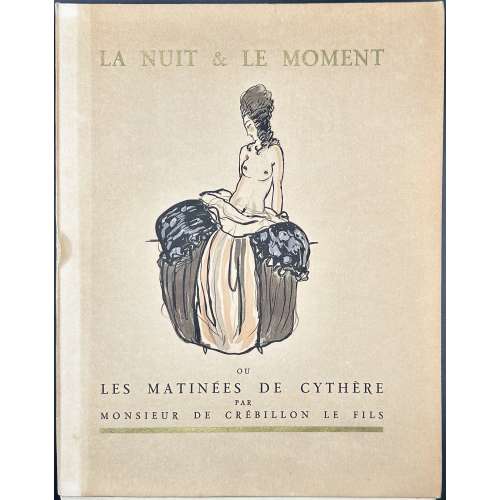 Softcover volume, 33 x 26 cm, collated in folio, not bound, in publisher’s French flapped pictorial wrappers, lettering to spine; printed on thick wove Arches paper watermarked “MBM”, upper edge trimmed, owner’s blind stamp to h.t. “Ex Libris Comte Tony de Vibraye”, glassine dust jacket, in a slipcase. Collation: π2 1-262, total 54 leaves, plus 4 leaves in wrappers, plus 10 plates, incl. frontispiece; coloured aquatints after Sylvain Sauvage; coloured etched vignette to front wrapper, gilt woodcut to back wrapper, woodcut title-page and woodcut headpiece after the same. Pp.: [4] [1] 2-102 [2]. Front wrapper (gilt and black): LA NUIT & LE MOMENT | {vignette} | OU | LES MATINÉES DE CYTHÈRE | PAR | MONSIEUR DE CRÉBILLON LE FILS | — || Title-page (woodcut): CRÉBILLON LE FILS | — | LA NUIT ET LE MOMENT | OU | LES MATINÉES | DE CYTHÈRE | {vignette} | A PARIS | AUX DEPENS D'UN AMATEUR | — | M CM XXIV || Limitation: De cette édition il a été tiré un exemplaire unique sur japon impérial comportant dix aquarelles originales, deux cents trente exemplaires sur vélin d' Arches numérotés 1 à 230, dont les dix premiers avec une suite de hors texte sur japon. N° 1 [Print run limited to 230 copies on Arches plus a unique copy on Japon with original watercolours, this is copy № 1 on wove paper]. Seller’s description: La Nuit et le moment ou Les Matinées de Cythère. Paris, Au dépens d'un amateur, 1924. In-4, en feuilles, non rogné, couverture illustrée et étui. Ouvrage illustré de 4 gravures sur bois et de 10 eaux-fortes libres en couleurs hors texte de Sylvain Sauvage. Tirage à 231 exemplaires, celui-ci le n°1 sur vélin d'Arches. Manque la suite de hors texte sur japon. De la bibliothèque du Comte Tony de Vibraye, avec cachet à froid. Dutel, n°2062. Catalogue raisonné: honesterotica.com; Dutel III 2062. Contributors: Claude-Prosper Jolyot de Crébillon [Crébillon fils] (French, 1707 – 1777) – author. Sylvain Sauvage [Félix Roy] (French, 1888 – 1948) – artist. Provenance: Antoine Henri Gaston Hurault de Vibraye [Comte Tony de Vibraye] (French, 1893 – 1951)
Softcover volume, 33 x 26 cm, collated in folio, not bound, in publisher’s French flapped pictorial wrappers, lettering to spine; printed on thick wove Arches paper watermarked “MBM”, upper edge trimmed, owner’s blind stamp to h.t. “Ex Libris Comte Tony de Vibraye”, glassine dust jacket, in a slipcase. Collation: π2 1-262, total 54 leaves, plus 4 leaves in wrappers, plus 10 plates, incl. frontispiece; coloured aquatints after Sylvain Sauvage; coloured etched vignette to front wrapper, gilt woodcut to back wrapper, woodcut title-page and woodcut headpiece after the same. Pp.: [4] [1] 2-102 [2]. Front wrapper (gilt and black): LA NUIT & LE MOMENT | {vignette} | OU | LES MATINÉES DE CYTHÈRE | PAR | MONSIEUR DE CRÉBILLON LE FILS | — || Title-page (woodcut): CRÉBILLON LE FILS | — | LA NUIT ET LE MOMENT | OU | LES MATINÉES | DE CYTHÈRE | {vignette} | A PARIS | AUX DEPENS D'UN AMATEUR | — | M CM XXIV || Limitation: De cette édition il a été tiré un exemplaire unique sur japon impérial comportant dix aquarelles originales, deux cents trente exemplaires sur vélin d' Arches numérotés 1 à 230, dont les dix premiers avec une suite de hors texte sur japon. N° 1 [Print run limited to 230 copies on Arches plus a unique copy on Japon with original watercolours, this is copy № 1 on wove paper]. Seller’s description: La Nuit et le moment ou Les Matinées de Cythère. Paris, Au dépens d'un amateur, 1924. In-4, en feuilles, non rogné, couverture illustrée et étui. Ouvrage illustré de 4 gravures sur bois et de 10 eaux-fortes libres en couleurs hors texte de Sylvain Sauvage. Tirage à 231 exemplaires, celui-ci le n°1 sur vélin d'Arches. Manque la suite de hors texte sur japon. De la bibliothèque du Comte Tony de Vibraye, avec cachet à froid. Dutel, n°2062. Catalogue raisonné: honesterotica.com; Dutel III 2062. Contributors: Claude-Prosper Jolyot de Crébillon [Crébillon fils] (French, 1707 – 1777) – author. Sylvain Sauvage [Félix Roy] (French, 1888 – 1948) – artist. Provenance: Antoine Henri Gaston Hurault de Vibraye [Comte Tony de Vibraye] (French, 1893 – 1951) -
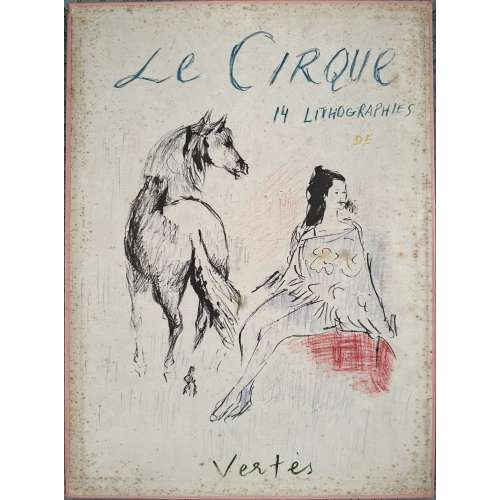 Publisher’s peach cloth box 555 x 410 mm with coloured lithograph on the lid, autographed with crayons "Le Cirque | 14 LITHOGRAPHIES | DE | {vignette} | Vertes"; in-folio unbound 4 pp. booklet on laid paper watermarked “Marais” and 14 loose leaves of plates on laid paper 520 x 395 mm without a watermark with coloured lithographs signed “Vertes” and numbered “195/250” in pencil; interleaved with tracing paper. Box and plates foxed. Title-page (red and black): LE | CIRQUE | 14 LITHOGRAPHIES DE | VERTÈS | PRÉSENTÉ | PAR | JEAN COCTEAU || Imprint: LES LIVES MERVEILLEUX | MONACO | Il a été tiré de cet album : | 150 Exemplaires, | destinés à | l'Amérique, | distribués bar les soins de | Arthur H. Harlow | de New-York, | & | 100 Exemplaires, | réservés à la France. | 15 Avril 1949 || Limitation: Edition limited to 250 copies (150 for USA, 100 for France); this is copy № 195 printed for France as the American copies marked “Published by Arthur H. Harlow & Co., New York. Seller’s Description: VERTÈS, Marcel (Hungarian-French, 1895-1961). Le Cirque 14 Lithographies de Vertès. Présénte par Jean Cocteau. [Monaco: Les Livres Merveilleux, 1949]. [vi] pp. With all 14 lithographs, each signed by the artist and numbered “195/250”. Text and lithographs 15 ¼ x 20 ½”. In original publisher’s peach cloth box with printed label on lid (box foxed, soiled, lightly worn; lithographs and text foxed). Still, a very good example of this lovely collection, with an introduction by Jean Cocteau (1889-1963). Catalogue Raisonné: Vokaer № 50. Marcel Vertès [Marcell Vértes] (Jewish-Hungarian-French, 1895 – 1961) – artist. Arthur H. Harlow (American, c. 1877 – 1958) – publisher. Jean Cocteau (French, 1889 – 1963) – author.
Publisher’s peach cloth box 555 x 410 mm with coloured lithograph on the lid, autographed with crayons "Le Cirque | 14 LITHOGRAPHIES | DE | {vignette} | Vertes"; in-folio unbound 4 pp. booklet on laid paper watermarked “Marais” and 14 loose leaves of plates on laid paper 520 x 395 mm without a watermark with coloured lithographs signed “Vertes” and numbered “195/250” in pencil; interleaved with tracing paper. Box and plates foxed. Title-page (red and black): LE | CIRQUE | 14 LITHOGRAPHIES DE | VERTÈS | PRÉSENTÉ | PAR | JEAN COCTEAU || Imprint: LES LIVES MERVEILLEUX | MONACO | Il a été tiré de cet album : | 150 Exemplaires, | destinés à | l'Amérique, | distribués bar les soins de | Arthur H. Harlow | de New-York, | & | 100 Exemplaires, | réservés à la France. | 15 Avril 1949 || Limitation: Edition limited to 250 copies (150 for USA, 100 for France); this is copy № 195 printed for France as the American copies marked “Published by Arthur H. Harlow & Co., New York. Seller’s Description: VERTÈS, Marcel (Hungarian-French, 1895-1961). Le Cirque 14 Lithographies de Vertès. Présénte par Jean Cocteau. [Monaco: Les Livres Merveilleux, 1949]. [vi] pp. With all 14 lithographs, each signed by the artist and numbered “195/250”. Text and lithographs 15 ¼ x 20 ½”. In original publisher’s peach cloth box with printed label on lid (box foxed, soiled, lightly worn; lithographs and text foxed). Still, a very good example of this lovely collection, with an introduction by Jean Cocteau (1889-1963). Catalogue Raisonné: Vokaer № 50. Marcel Vertès [Marcell Vértes] (Jewish-Hungarian-French, 1895 – 1961) – artist. Arthur H. Harlow (American, c. 1877 – 1958) – publisher. Jean Cocteau (French, 1889 – 1963) – author. -
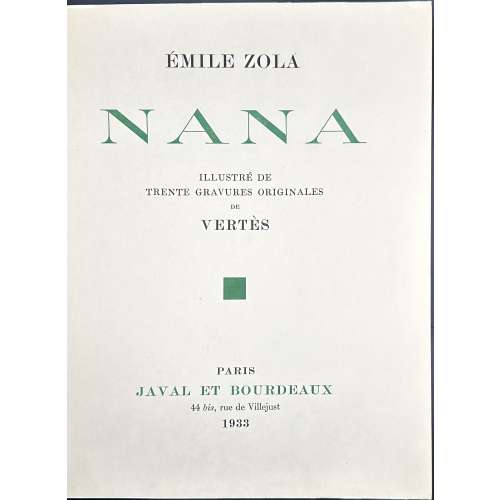 Publisher’s olive French flapped wrappers, in-4to, 33 x 25.3 x 6 cm, green and black lettering to front and spine, in a glassine dust jacket, in a marbled double slipcase 34.5 x 25.5 cm, unbound; pp.: [8] 1-436 [4], plus 30 colour plates with guard tissue, extraneous to collation; edition enriched with a set of 30 uncoloured etchings with guard tissue in a lettered paper folder. Title-page: ÉMILE ZOLA | NANA | ILLUSTRÉ DE | TRENTE GRAVURES ORIGINALES | DE | VERTÈS |◾| PARIS | JAVAL ET BOURDEAUX | 44 bis, rue de Villejust | 1933 || Justification du tirage: il a été tiré de «Nana » d'Émile Zola. Soixante exemplaires sur japon impérial, numérotés de 1 a 60, avec un état en couleurs colorié a la main et un état en noir des trente gravures originales de Vertès. [Edition limited to 60 copies, this is copy № 54]. Colophon: « NANA », D'ÉMILE ZOLA, ÉTÉ ACHEVÉ D'IMPRIMER LE TRENTE AVRIL MIL NEUF CENT TRENTE-TROIS, EN CARACTÈRES ROMAIN ANGLAIS DU CORPS 16, SUR LES PRESSES DU MAITRE IMPRIMEUR COULOUMA, À ARGENTEUIL, H. BARTHÉLEMY, DIRECTEUR. LES COMPOSITIONS DE VERTÈS ONT ÉTÉ REPRODUITES EN FAC-SIMILÉ PAR D. JACOMET & Cie. Printed on April 30, 1933 by Coulouma in Argenteuil, H. Barthélemy, director; illustrations reproduced in facsimile by D. Jacomet & Co. Catalogue raisonné: Vokaer 30. Contributors: Émile Zola (French, 1840 – 1902) – author. Marcel Vertès [Marcell Vértes] (Jewish-Hungarian-French, 1895 – 1961) – artist. Javal et Bourdeaux – publisher. Daniel Jacomet (French, 1894 – 1966) – printer. Seller's description: Nana. Paris, Javal et Bourdeaux, 1933. 2 volumes in-4, en feuilles, non coupé, non rogné, chemise et étui. Ouvrage illustré de 30 gravures originales en couleurs de Marcel Vertès. Tirage à 60 exemplaires sur japon impérial contenant un état des illustrations coloriées à la main en couleurs et un état en noir. Chemise et emboîtage insolés.
Publisher’s olive French flapped wrappers, in-4to, 33 x 25.3 x 6 cm, green and black lettering to front and spine, in a glassine dust jacket, in a marbled double slipcase 34.5 x 25.5 cm, unbound; pp.: [8] 1-436 [4], plus 30 colour plates with guard tissue, extraneous to collation; edition enriched with a set of 30 uncoloured etchings with guard tissue in a lettered paper folder. Title-page: ÉMILE ZOLA | NANA | ILLUSTRÉ DE | TRENTE GRAVURES ORIGINALES | DE | VERTÈS |◾| PARIS | JAVAL ET BOURDEAUX | 44 bis, rue de Villejust | 1933 || Justification du tirage: il a été tiré de «Nana » d'Émile Zola. Soixante exemplaires sur japon impérial, numérotés de 1 a 60, avec un état en couleurs colorié a la main et un état en noir des trente gravures originales de Vertès. [Edition limited to 60 copies, this is copy № 54]. Colophon: « NANA », D'ÉMILE ZOLA, ÉTÉ ACHEVÉ D'IMPRIMER LE TRENTE AVRIL MIL NEUF CENT TRENTE-TROIS, EN CARACTÈRES ROMAIN ANGLAIS DU CORPS 16, SUR LES PRESSES DU MAITRE IMPRIMEUR COULOUMA, À ARGENTEUIL, H. BARTHÉLEMY, DIRECTEUR. LES COMPOSITIONS DE VERTÈS ONT ÉTÉ REPRODUITES EN FAC-SIMILÉ PAR D. JACOMET & Cie. Printed on April 30, 1933 by Coulouma in Argenteuil, H. Barthélemy, director; illustrations reproduced in facsimile by D. Jacomet & Co. Catalogue raisonné: Vokaer 30. Contributors: Émile Zola (French, 1840 – 1902) – author. Marcel Vertès [Marcell Vértes] (Jewish-Hungarian-French, 1895 – 1961) – artist. Javal et Bourdeaux – publisher. Daniel Jacomet (French, 1894 – 1966) – printer. Seller's description: Nana. Paris, Javal et Bourdeaux, 1933. 2 volumes in-4, en feuilles, non coupé, non rogné, chemise et étui. Ouvrage illustré de 30 gravures originales en couleurs de Marcel Vertès. Tirage à 60 exemplaires sur japon impérial contenant un état des illustrations coloriées à la main en couleurs et un état en noir. Chemise et emboîtage insolés. -
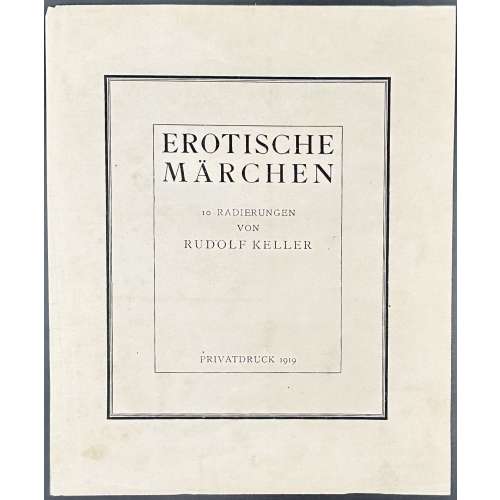 Portfolio 265 x 225 mm, black half-buckram over diapered cardboard with flaps, black with gilt lettering in frame to front “R. KELLER | MÄRCHEN”, t.p. printed on wave paper, the folder and engravings printed on laid paper, 10 loose plates, 240 x 210 mm sheet, 135 x 110-115 mm plate; re-issue of ten plates of the first edition of 16 plates published in Austria in c. 1910s. Title-page: EROTISCHE | MÄRCHEN | 10 RADIERUNGEN | VON | RUDOLF KELLER | PRIVATDRUCK 1919 || Die Mappe enthält folgende originalradierungen: 1. Aschenbrödel; 2. Dornröschen; 3. Zwerg Nase; 4. Froschkönig; 5. Der gestiefelte Kater; 6. Hänsel und Gretel; 7. Der fliegende Koffer; 8. Schneewittchen mit den 7 Zwergen; 9. Die kleine Seejungfer; 10. Der kleine Daumling Dieses Werk wurde in einer einmaligen Auflage von 250 numerierten Exemplaren hergestellt und darf nur an Gelehrte und Sammler abgegeben werden. Die Platten wurden vernichtet. Nr. 1—50 sind vom Künstler signierte Vorzugsdrucke. Dieses Exemplar erhielt Nr. 0153. Translation: The folder contains the following original etchings: 1. Cinderella; 2. Sleeping Beauty; 3. Dwarf nose; 4. The Frog Prince; 5. Puss in Boots; 6. Hansel and Gretel; 7. The Flying Trunk; 8. Snow White with the Seven Dwarfs; 9. The Little Mermaid; 10. Little Thumbling. This work was produced in a one-time edition of 250 numbered copies and may only be sold to scholars and collectors. The copperplates were destroyed. Nos. 1-50 are special prints signed by the artist. This copy was given number 0153. Seller's description: Erotische Märchen. S.l., Privatdruck, 1919. In-8, en feuilles, sous chemise demi-chagrin vert recouverte de papier japonais. Recueil de 10 eaux-fortes originales de Rudolf Keller. Ces eaux-fortes érotiques dans les teintes brunes s'inspirent des contes de fées traditionnels comme Cendrillon, La Belle au bois dormant, Hansel et Gretel, Blanche-Neige, Le Petit Poucet etc. Tirage à 250 exemplaires. Chemise défraîchie. Jacob Grimm (German; 1785 – 1863) Wilhelm Grimm (German, 1786 – 1859) Charles Perrault (French, 1628 – 1703) Hans Christian Andersen (Danish, 1805 – 1875)
Portfolio 265 x 225 mm, black half-buckram over diapered cardboard with flaps, black with gilt lettering in frame to front “R. KELLER | MÄRCHEN”, t.p. printed on wave paper, the folder and engravings printed on laid paper, 10 loose plates, 240 x 210 mm sheet, 135 x 110-115 mm plate; re-issue of ten plates of the first edition of 16 plates published in Austria in c. 1910s. Title-page: EROTISCHE | MÄRCHEN | 10 RADIERUNGEN | VON | RUDOLF KELLER | PRIVATDRUCK 1919 || Die Mappe enthält folgende originalradierungen: 1. Aschenbrödel; 2. Dornröschen; 3. Zwerg Nase; 4. Froschkönig; 5. Der gestiefelte Kater; 6. Hänsel und Gretel; 7. Der fliegende Koffer; 8. Schneewittchen mit den 7 Zwergen; 9. Die kleine Seejungfer; 10. Der kleine Daumling Dieses Werk wurde in einer einmaligen Auflage von 250 numerierten Exemplaren hergestellt und darf nur an Gelehrte und Sammler abgegeben werden. Die Platten wurden vernichtet. Nr. 1—50 sind vom Künstler signierte Vorzugsdrucke. Dieses Exemplar erhielt Nr. 0153. Translation: The folder contains the following original etchings: 1. Cinderella; 2. Sleeping Beauty; 3. Dwarf nose; 4. The Frog Prince; 5. Puss in Boots; 6. Hansel and Gretel; 7. The Flying Trunk; 8. Snow White with the Seven Dwarfs; 9. The Little Mermaid; 10. Little Thumbling. This work was produced in a one-time edition of 250 numbered copies and may only be sold to scholars and collectors. The copperplates were destroyed. Nos. 1-50 are special prints signed by the artist. This copy was given number 0153. Seller's description: Erotische Märchen. S.l., Privatdruck, 1919. In-8, en feuilles, sous chemise demi-chagrin vert recouverte de papier japonais. Recueil de 10 eaux-fortes originales de Rudolf Keller. Ces eaux-fortes érotiques dans les teintes brunes s'inspirent des contes de fées traditionnels comme Cendrillon, La Belle au bois dormant, Hansel et Gretel, Blanche-Neige, Le Petit Poucet etc. Tirage à 250 exemplaires. Chemise défraîchie. Jacob Grimm (German; 1785 – 1863) Wilhelm Grimm (German, 1786 – 1859) Charles Perrault (French, 1628 – 1703) Hans Christian Andersen (Danish, 1805 – 1875) -
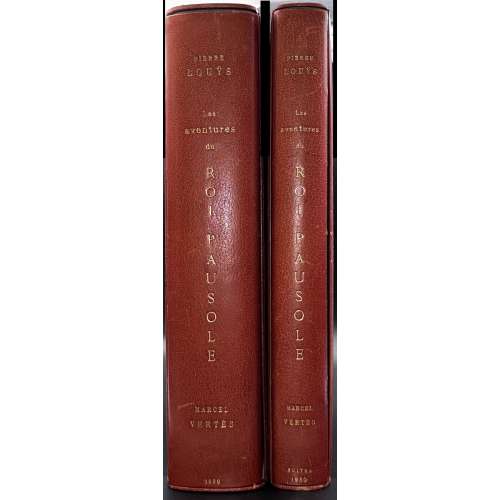 Two volumes in owner’s uniform so called Jansenist binding by someone Alix (signed in gilt inside), gilt lettering to spine, each in a slipcase. Vol. 1: full crimson morocco 32.5 x 26 x 6.5 cm in a 33.3 x 27 x 7 cm slipcase, cloth endpapers, all edges gilt, publisher’s wrappers preserved, autographed drawing by Vertès to h.t. “à monsieur Willard | bien sympathiquement | Vertès | Paris 1930”. Collation: 3 blanks, front wrapper, 2 blanks, [10] h.t./limit., t.p., art., dedic., person., [2] 3-487 [488 blank], [2] coloph., 3 blanks, spine, 3 blanks; 74 dry-point illustrations by Marcel Vertès within collation; printed on thick wove paper by ‘Arches’ watermarked “Pausole & Vertès”. Title-page (red and black): LES AVENTURES | DU | ROI PAUSOLE | de | PIERRE LOUŸS | {vignette} | AUX DÉPENS D'UN AMATEUR | PARIS, MCMXXX || Limitation: CETTE ÉDITION DU ROMAN | DE |PIERRE LOUŸS | LES AVENTURES DU ROI PAUSOLE | A ÉTE COMPOSE EN CARACTÈRE GARAMOND DU CORPS 18 | ET IMPRIMEE SUR VÉLIN A LA FORME DES PAPETERIES | D' ARCHES FILIGRANÉ | PAUSOLE & VERTÈS | ELLE EST ILLUSTRÉE DE SOIXANTE-QUATORZE | POINTES-SÈCHES ORIGINALES | DE | VERTÈS | SON TIRAGE A ÉTÉ STRICTEMENT LIMITÉ A | QUATRE-VINGT-DIX-NEUF EXEMPLAIRES NUMÉROTÉS | DE 1 A 99 ET CONTENANT : | 1° LA SUITE DES CUIVRES AVEC REMAROUES. | 2° UNE SUITE DES 15 PLANCHES REFUSÉES. | IL A ÉTÉ TIRÉ EN OUTRE, POUR L' ARTISTE ET LES COLLABORATEURS, | QUELQUES EXEMPLAIRES NOMINATIFS, DONT DEUX IMPRIMÉS SUR PAPIER | CHIFFE D'AUVERGNE A LA MAIN | EXEMPLAIRE | № 9 || Colophon: Cet ouvrage, établi aux dépens de m. L. Givaudan, a été achevé d'imprimer le quinze novembre mil neuf cent trente, pour le texte, sur les presses de R. Coulouma, maitre imprimeur a Argenteuil, H. Barthélemy, directeur, et pour les pointes-sèches, dans les ateliers de «La Tradition", a Paris. Limited edition of 99 copies, this is copy № 9. Vol. 2: Three-quarters crimson morocco over cloth outlined gilt, 32.7 x 27.8 x 4 cm in a 33.3 x 28.2 x 4.3 cm slipcase, cloth endpapers, all edges gilt, printed on thick wove paper by ‘Arches’ watermarked “Pausole & Vertès”. Collation: 3 blanks, 74 unpaginated leaves of plates (main suite avec remarque), blank, 15 leaves of plates (refusées), t.p./limit., blank, 30 leaves of plates (15 prints in two states each, with and without ‘remarks’) titled Au pays du Roi Pausole, 3 blanks. Title-page (red and black): AU PAYS | DU | ROI PAUSOLE | Quinze cuivres | gravés par un artiste | inconnu | de la suite | du Roi | ❦ | —| TRYPHÈME. MCMXXX. || Limitation: IL A ÉTÉ TIRÉDE CETTE SUITE | DE POINTES-SÈCHES VINGT- | CINQ EXEMPLAIRES SUR VÉ- | LIN A LA FORME DES PAPETE- | RIES ARCHES AU FILIGRANE | DE PAUSOLE. CES SUITES NON | MISES DANS LE COMMERCE | SONT RÉSERVÉES A SA MAJES- | TÉ, AUX REINES PRÉFÉRÉES | PARMI LL. AA. RR. ET A QUEL- | QUES FIDÈLES SERVITEURS. | № 13 || Limited edition of 25 copies, this is copy № 13; Enriched with an original copper plate with one of the illustrations. Marcel Willard (French, – provenance. Catalogue raisonné: Dutel (III) 1057; Nordmann (II) № 307; Vokaer 26. Ref.: honesterotica.com Contributors: Pierre Louÿs (French, 1870 – 1925) – author. Marcel Vertès [Marcell Vértes] (Jewish-Hungarian-French, 1895 – 1961) – artist. Léon Givaudan (French, 1875 – 1936) – publisher. Seller's description:Les Aventures du Roi Pausole. Paris, Aux dépens d'un amateur, 1930. 2 volumes in-4, maroquin rouge janséniste, tranches dorée, couverture et dos, emboîtage. Le volume de suites est relié en demi-maroquin rouge. (Alix). Ouvrage illustré de 74 pointes-sèches de Marcel Vertès. Tirage à 99 exemplaires sur vélin d'Arches, comportant la suite des cuivres avec remarque, ainsi qu'une suite des 15 planches refusées. Exemplaire enrichi d'une plaque de cuivre ayant servi à une des illustrations, d'un dessin avec envoi autographe signé de l'artiste sur la page de faux-titre et d'une double suite des 15 pointes-sèches par un artiste inconnu intitulée Au Pays du roi Pausole. Dos légèrement passés.
Two volumes in owner’s uniform so called Jansenist binding by someone Alix (signed in gilt inside), gilt lettering to spine, each in a slipcase. Vol. 1: full crimson morocco 32.5 x 26 x 6.5 cm in a 33.3 x 27 x 7 cm slipcase, cloth endpapers, all edges gilt, publisher’s wrappers preserved, autographed drawing by Vertès to h.t. “à monsieur Willard | bien sympathiquement | Vertès | Paris 1930”. Collation: 3 blanks, front wrapper, 2 blanks, [10] h.t./limit., t.p., art., dedic., person., [2] 3-487 [488 blank], [2] coloph., 3 blanks, spine, 3 blanks; 74 dry-point illustrations by Marcel Vertès within collation; printed on thick wove paper by ‘Arches’ watermarked “Pausole & Vertès”. Title-page (red and black): LES AVENTURES | DU | ROI PAUSOLE | de | PIERRE LOUŸS | {vignette} | AUX DÉPENS D'UN AMATEUR | PARIS, MCMXXX || Limitation: CETTE ÉDITION DU ROMAN | DE |PIERRE LOUŸS | LES AVENTURES DU ROI PAUSOLE | A ÉTE COMPOSE EN CARACTÈRE GARAMOND DU CORPS 18 | ET IMPRIMEE SUR VÉLIN A LA FORME DES PAPETERIES | D' ARCHES FILIGRANÉ | PAUSOLE & VERTÈS | ELLE EST ILLUSTRÉE DE SOIXANTE-QUATORZE | POINTES-SÈCHES ORIGINALES | DE | VERTÈS | SON TIRAGE A ÉTÉ STRICTEMENT LIMITÉ A | QUATRE-VINGT-DIX-NEUF EXEMPLAIRES NUMÉROTÉS | DE 1 A 99 ET CONTENANT : | 1° LA SUITE DES CUIVRES AVEC REMAROUES. | 2° UNE SUITE DES 15 PLANCHES REFUSÉES. | IL A ÉTÉ TIRÉ EN OUTRE, POUR L' ARTISTE ET LES COLLABORATEURS, | QUELQUES EXEMPLAIRES NOMINATIFS, DONT DEUX IMPRIMÉS SUR PAPIER | CHIFFE D'AUVERGNE A LA MAIN | EXEMPLAIRE | № 9 || Colophon: Cet ouvrage, établi aux dépens de m. L. Givaudan, a été achevé d'imprimer le quinze novembre mil neuf cent trente, pour le texte, sur les presses de R. Coulouma, maitre imprimeur a Argenteuil, H. Barthélemy, directeur, et pour les pointes-sèches, dans les ateliers de «La Tradition", a Paris. Limited edition of 99 copies, this is copy № 9. Vol. 2: Three-quarters crimson morocco over cloth outlined gilt, 32.7 x 27.8 x 4 cm in a 33.3 x 28.2 x 4.3 cm slipcase, cloth endpapers, all edges gilt, printed on thick wove paper by ‘Arches’ watermarked “Pausole & Vertès”. Collation: 3 blanks, 74 unpaginated leaves of plates (main suite avec remarque), blank, 15 leaves of plates (refusées), t.p./limit., blank, 30 leaves of plates (15 prints in two states each, with and without ‘remarks’) titled Au pays du Roi Pausole, 3 blanks. Title-page (red and black): AU PAYS | DU | ROI PAUSOLE | Quinze cuivres | gravés par un artiste | inconnu | de la suite | du Roi | ❦ | —| TRYPHÈME. MCMXXX. || Limitation: IL A ÉTÉ TIRÉDE CETTE SUITE | DE POINTES-SÈCHES VINGT- | CINQ EXEMPLAIRES SUR VÉ- | LIN A LA FORME DES PAPETE- | RIES ARCHES AU FILIGRANE | DE PAUSOLE. CES SUITES NON | MISES DANS LE COMMERCE | SONT RÉSERVÉES A SA MAJES- | TÉ, AUX REINES PRÉFÉRÉES | PARMI LL. AA. RR. ET A QUEL- | QUES FIDÈLES SERVITEURS. | № 13 || Limited edition of 25 copies, this is copy № 13; Enriched with an original copper plate with one of the illustrations. Marcel Willard (French, – provenance. Catalogue raisonné: Dutel (III) 1057; Nordmann (II) № 307; Vokaer 26. Ref.: honesterotica.com Contributors: Pierre Louÿs (French, 1870 – 1925) – author. Marcel Vertès [Marcell Vértes] (Jewish-Hungarian-French, 1895 – 1961) – artist. Léon Givaudan (French, 1875 – 1936) – publisher. Seller's description:Les Aventures du Roi Pausole. Paris, Aux dépens d'un amateur, 1930. 2 volumes in-4, maroquin rouge janséniste, tranches dorée, couverture et dos, emboîtage. Le volume de suites est relié en demi-maroquin rouge. (Alix). Ouvrage illustré de 74 pointes-sèches de Marcel Vertès. Tirage à 99 exemplaires sur vélin d'Arches, comportant la suite des cuivres avec remarque, ainsi qu'une suite des 15 planches refusées. Exemplaire enrichi d'une plaque de cuivre ayant servi à une des illustrations, d'un dessin avec envoi autographe signé de l'artiste sur la page de faux-titre et d'une double suite des 15 pointes-sèches par un artiste inconnu intitulée Au Pays du roi Pausole. Dos légèrement passés. -
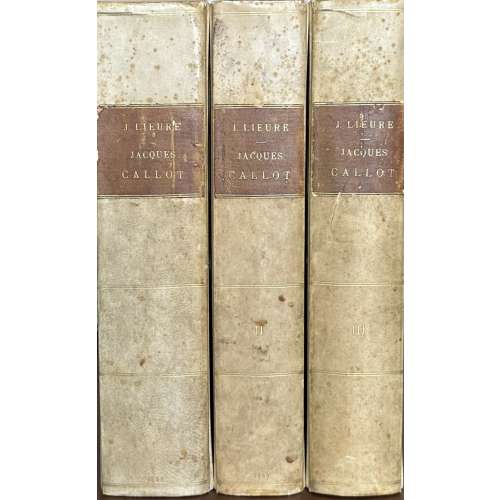 Three volumes, 33 x 26.5 x 7 cm each, uniformly bound in 2/3 vellum over marbled boards, outlined with gilt fillet, brown label with gilt lettering to flat spine with double fillet faux-bands, marbled endpapers, top edge gilt, other untrimmed, publisher’s wrappers preserved, incl. spine; collotype plates with captioned glassine guards; armorial bookplate of Comte Alain de Suzannet to front pastedown in each volume. Two volumes of Première partie, wanting, contain La vie artistique : texte and La vie artistique : planches. Title-page (red and black): JACQUES CALLOT | PAR | J. LIEURE | Introduction de F. Courboin | Conservateur du Cabinet des Estampes à la Bibliothèque Nationale | — | DEUXIÈME PARTIE | CATALOGUE DE L’ŒUVRE GRAVÉ | TOME I (II, III) | — | PARIS | ÉDITIONS DE LA GAZETTE DES BEAUX-ARTS | 106, Boulevard Saint-Germain (6e) | 1924 (1927, 1927) || Vol. 1 (1924): [4] [1] 2-122 [2], wrappers, plates 1-299; printed on September 15, 1924, by André Lesot (Nemours) and D. Jacomet et Cie (Paris). Vol. 2 (1927): [4] [1] 2-106 [2], wrappers, plates 300-652. Vol. 3 (1927): [4] [1] 2-128 [4], wrappers, plates 653-1428; printed on September 5, 1926, by Imprimerie moderne des Beaux-Arts (Bois-Colombes) and D. Jacomet et Cie (Paris). Contributors: Jules Lieure (French, 1866 – 1948) – author. Jacques Callot (French, c. 1592 – 1635) – artist. Gazette des Beaux-Arts (f. 1859) – publisher. François Courboin (French, 1865 – 1926) – author. D. Jacomet et Cie (Paris) – printer. Daniel Jacomet (French, 1894 – 1966) – printer. André Lesot (French, 1874-1951) – printer. Imprimerie moderne des Beaux-Arts (Bois-Colombes) Comte Alain de Suzannet (French, 1882 – 1950) – provenance.
Three volumes, 33 x 26.5 x 7 cm each, uniformly bound in 2/3 vellum over marbled boards, outlined with gilt fillet, brown label with gilt lettering to flat spine with double fillet faux-bands, marbled endpapers, top edge gilt, other untrimmed, publisher’s wrappers preserved, incl. spine; collotype plates with captioned glassine guards; armorial bookplate of Comte Alain de Suzannet to front pastedown in each volume. Two volumes of Première partie, wanting, contain La vie artistique : texte and La vie artistique : planches. Title-page (red and black): JACQUES CALLOT | PAR | J. LIEURE | Introduction de F. Courboin | Conservateur du Cabinet des Estampes à la Bibliothèque Nationale | — | DEUXIÈME PARTIE | CATALOGUE DE L’ŒUVRE GRAVÉ | TOME I (II, III) | — | PARIS | ÉDITIONS DE LA GAZETTE DES BEAUX-ARTS | 106, Boulevard Saint-Germain (6e) | 1924 (1927, 1927) || Vol. 1 (1924): [4] [1] 2-122 [2], wrappers, plates 1-299; printed on September 15, 1924, by André Lesot (Nemours) and D. Jacomet et Cie (Paris). Vol. 2 (1927): [4] [1] 2-106 [2], wrappers, plates 300-652. Vol. 3 (1927): [4] [1] 2-128 [4], wrappers, plates 653-1428; printed on September 5, 1926, by Imprimerie moderne des Beaux-Arts (Bois-Colombes) and D. Jacomet et Cie (Paris). Contributors: Jules Lieure (French, 1866 – 1948) – author. Jacques Callot (French, c. 1592 – 1635) – artist. Gazette des Beaux-Arts (f. 1859) – publisher. François Courboin (French, 1865 – 1926) – author. D. Jacomet et Cie (Paris) – printer. Daniel Jacomet (French, 1894 – 1966) – printer. André Lesot (French, 1874-1951) – printer. Imprimerie moderne des Beaux-Arts (Bois-Colombes) Comte Alain de Suzannet (French, 1882 – 1950) – provenance. -
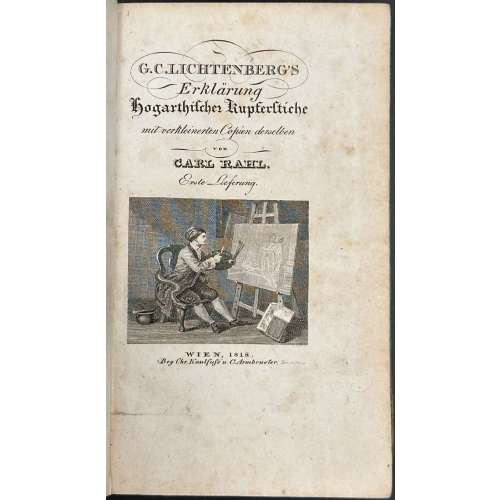 Three hardcover volumes, in-12mo, 16.2 x 10.6 cm each, uniformly bound in quarter brown cloth over marbled boards, all margins marbled, gilt lettering to spine; plus an oblong volume of similar binding, 24.5 x 39.5 cm, with 88 engraved plates by Riepenhausen after Hogarth (83 pp, unnumbered). Catalogue raisonné of William Hogarth's engravings, published by Carl Armbruster in Vienna and Dieterichsche Buchhandlung in Göttingen. A detailed explanation of Hogarth's prints divided in 14 parts. Vol. 1.
Three hardcover volumes, in-12mo, 16.2 x 10.6 cm each, uniformly bound in quarter brown cloth over marbled boards, all margins marbled, gilt lettering to spine; plus an oblong volume of similar binding, 24.5 x 39.5 cm, with 88 engraved plates by Riepenhausen after Hogarth (83 pp, unnumbered). Catalogue raisonné of William Hogarth's engravings, published by Carl Armbruster in Vienna and Dieterichsche Buchhandlung in Göttingen. A detailed explanation of Hogarth's prints divided in 14 parts. Vol. 1.- C. G. Lichtenberg’s Ausführliche Erklärung der Hogarthischen Kupferstiche, mit verkleinerten Copien derselben von Carl Rahl. Erste Lieferung. Wien, 1818. Bey Chr. Kaulfuß und C. Armbruster. Gedruckt bey Anton Strauß. [i-v] vi-xxxvi, [1-3] 4-136, plus engraved t.p.
- C. G. Lichtenberg’s Ausführliche Erklärung der Hogarthischen Kupferstiche, mit verkleinerten Copien derselben von Carl Rahl. Zweite Lieferung. Wien, 1818. Bey Chr. Kaulfuß und C. Armbruster. Gedruckt bey Anton Strauß. [i-iii] iv-viii [2] 11-207 [1 blank], plus engraved t.p.
- C. G. Lichtenberg’s Ausführliche Erklärung der Hogarthischen Kupferstiche, mit verkleinerten Copien derselben von Carl Rahl. Dritte Lieferung. Wien, 1818. Bey Chr. Kaulfuß und C. Armbruster. Gedruckt bey Anton Strauß. [i-iii] iv-vi [3] 10-215 [1 blank], plus engraved t.p.
- C. G. Lichtenberg’s Ausführliche Erklärung der Hogarthischen Kupferstiche, mit verkleinerten Copien derselben von Carl Rahl. Vierte Lieferung. Wien, 1818. Bey Chr. Kaulfuß und C. Armbruster. Gedruckt bey Anton Strauß. [1-5] 6-180 [1 blank], plus engraved t.p.
- C. G. Lichtenberg’s Ausführliche Erklärung der Hogarthischen Kupferstiche, mit verkleinerten Copien derselben von Carl Rahl. Fünste Lieferung. Wien, bey Carl Armbruster 1819. Gedruckt bey Anton Strauß. [1-3] 4-144, plus engraved t.p.
- C. G. Lichtenberg’s Ausführliche Erklärung der Hogarthischen Kupferstiche, mit verkleinerten Copien derselben von Carl Rahl. Sechste Lieferung. Mit zufåßen nach den schriften der englischen Erflårer. Wien, bey Carl Armbruster 1819. Gedruckt bey Anton Strauß. [i-iii] iv-x [2] 13-100, plus engraved t.p.
- C. G. Lichtenberg’s Ausführliche Erklärung der Hogarthischen Kupferstiche, mit verkleinerten Copien derselben von Carl Rahl. Siebente und achte Lieferung. Mit zufåßen nach den Schriften der englischen Erflårer. Wien, bey Carl Armbruster 1820. Gedruckt bey Anton Strauß. [1-8] 9-191, plus engraved t.p.
- C. G. Lichtenberg’s Ausführliche Erklärung der Hogarthischen Kupferstiche, mit verkleinerten Copien derselben von Carl Rahl. Neunte und zehnte Lieferung. Mit zufåßen nach den Schriften der englischen Erflårer. Wien, bey Carl Armbruster 1823. Gedruckt bey Anton Strauß. [1-7] 8-168, plus engraved t.p.
- C. G. Lichtenberg’s Erklärung der Hogarthischen Kupferstiche, mit verkleinerten aber vollständigen Copien derselben von E. Riepenhausen. Eilfte Lieferung mit zufåßen nach den schriften der englischen Erflårer. Göttingen in der Dieterichsche Buchhandlung 1809. [1-3] 4-81 [82 blank].
- C. G. Lichtenberg’s Ausführliche Erklärung der Hogarthischen Kupferstiche, mit verkleinerten aber vollständigen Copien derselben von E. Riepenhausen fortgefeßt vom Berausgeber der fechsten Lieferung mit Benußung der englischen Erflårer. Zwölfte Lieferung. Göttingen in der Dieterichsche Buchhandlung 1816. [i-iii] iv [1-3] 4-76.
- J. P. Lyser’s Ausführliche Erklärung der Hogarthischen Kupferstiche, mit verkleinerten aber vollständigen Copien derselben von E. Riepenhausen. Dreizehnte Lieferung Göttingen in der Dieterichsche Buchhandlung 1833. [i-v] vi-xii, [1-3] 4-117 [118].
- Dr. le Petit’s Ausführliche Erklärung der Hogarthischen Kupferstiche, mit verkleinerten aber vollständigen Copien derselben von E. Riepenhausen, Berausgeber Karl Gutzkow. Vierzehnte Lieferung. Göttingen in der Dieterichsche Buchhandlung 1835. [i-iii] iv-xvi, [1-3] 4-132.
-
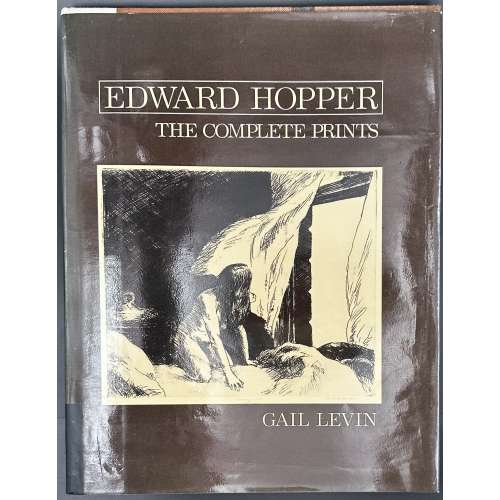 Hardcover volume, 28.6 x 22.4 cm, tan cloth over brown cloth boards, black lettering to spine, blind-stamped lettering in frame to front, in a black pictorial dust jacket, price unclipped; pp.: [1-ix] x-xi [xii blank], [1-4] 5-36 [4], 64 pages with 109 b/w plates, 12 pages with chronology, bibliography, credits; total 128 pp. Title-page: EDWARD HOPPER (in frame)| THE COMPLETE PRINTS | GAIL LEVIN | W • W • NORTON & COMPANY • NEW YORK • LONDON | IN ASSOCIATION WITH THE | WHITNEY MUSEUM OF AMERICAN ART || Contributors: Gail Levin (American, b. 1948) – author. Edward Hopper (American, 1882 – 1967) – artist. W. W. Norton & Company (f. 1923) – publisher. Whitney Museum of American Art (NY) – publisher.
Hardcover volume, 28.6 x 22.4 cm, tan cloth over brown cloth boards, black lettering to spine, blind-stamped lettering in frame to front, in a black pictorial dust jacket, price unclipped; pp.: [1-ix] x-xi [xii blank], [1-4] 5-36 [4], 64 pages with 109 b/w plates, 12 pages with chronology, bibliography, credits; total 128 pp. Title-page: EDWARD HOPPER (in frame)| THE COMPLETE PRINTS | GAIL LEVIN | W • W • NORTON & COMPANY • NEW YORK • LONDON | IN ASSOCIATION WITH THE | WHITNEY MUSEUM OF AMERICAN ART || Contributors: Gail Levin (American, b. 1948) – author. Edward Hopper (American, 1882 – 1967) – artist. W. W. Norton & Company (f. 1923) – publisher. Whitney Museum of American Art (NY) – publisher. -
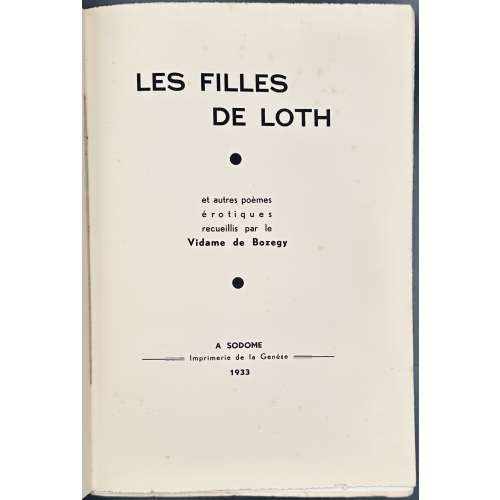 Softcover, french flapped wrappers, 29 x 19 cm, in glassine dustjacket, text printed on laid paper, pp.: [1-10] 11-256 [8], total 264 pages plus 11 plates out of 12, hand-coloured etchings on wove paper laid in, extraneous to collation. Wrappers detached from the block. Some pages uncut. Below is the missing plate, according to honesterotica.com:
Softcover, french flapped wrappers, 29 x 19 cm, in glassine dustjacket, text printed on laid paper, pp.: [1-10] 11-256 [8], total 264 pages plus 11 plates out of 12, hand-coloured etchings on wove paper laid in, extraneous to collation. Wrappers detached from the block. Some pages uncut. Below is the missing plate, according to honesterotica.com: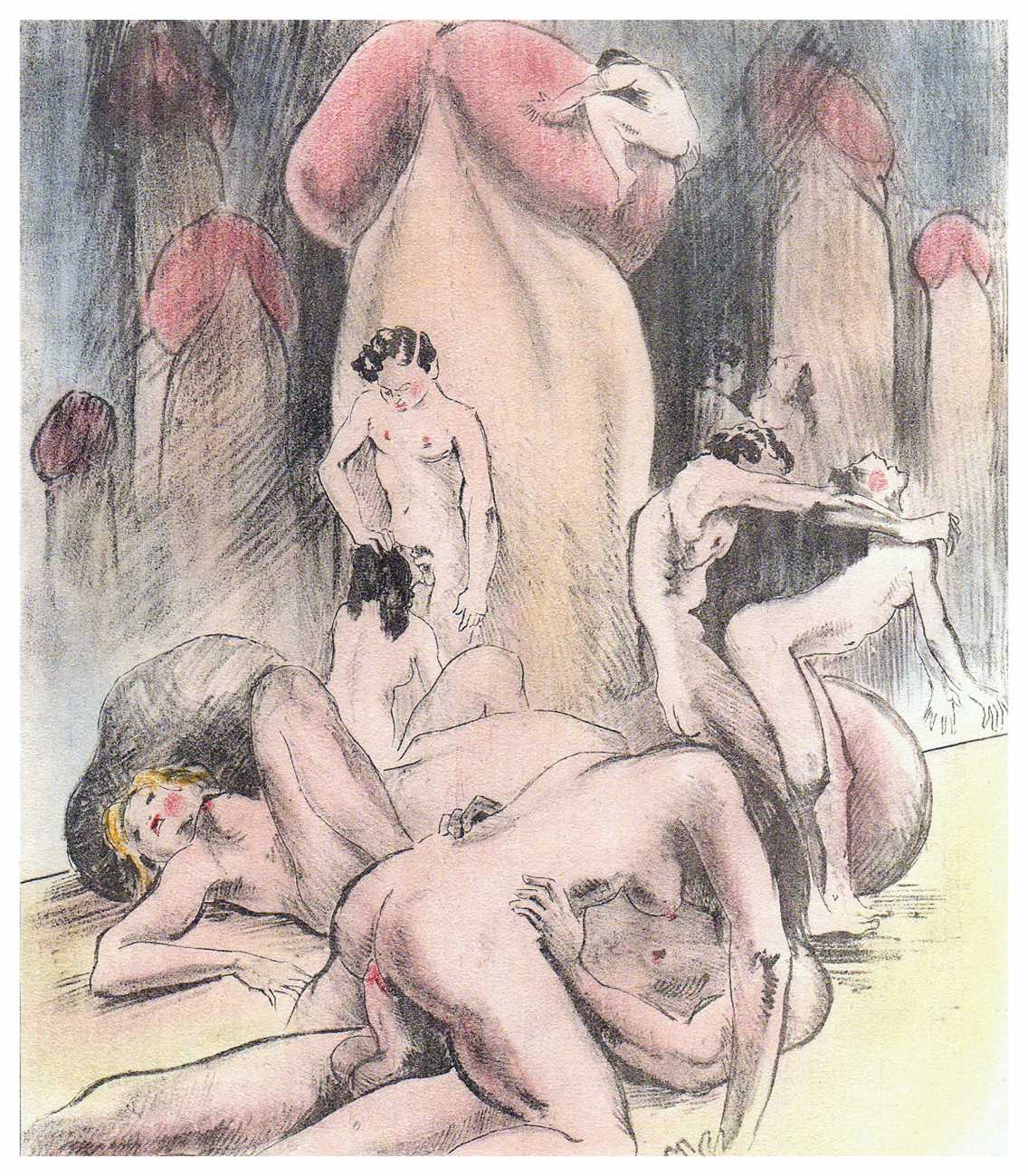 Title-page: LES FILLES | DE LOTH | • | et autres poèmes | érotiques | recueillis par le | Vidame de Bozegy | • | A SODOME | — Imprimerie de la Genèse — | 1933 ||
Edition limited to 500 copies, this is copy № 54.
Catalogue raisonné: Dutel III № 1575.
Edmond Dardenne Bernard [Vidame de Bozegy] (French, 20th c.) – author.
André Collot (French, 1897 – 1976) – artist.
Title-page: LES FILLES | DE LOTH | • | et autres poèmes | érotiques | recueillis par le | Vidame de Bozegy | • | A SODOME | — Imprimerie de la Genèse — | 1933 ||
Edition limited to 500 copies, this is copy № 54.
Catalogue raisonné: Dutel III № 1575.
Edmond Dardenne Bernard [Vidame de Bozegy] (French, 20th c.) – author.
André Collot (French, 1897 – 1976) – artist. -
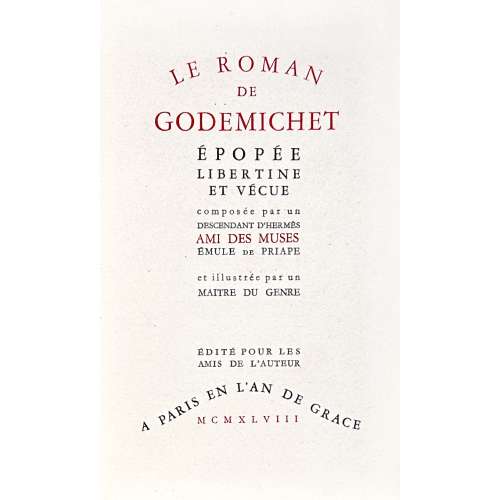 Softcover volume, 23.5 x 15 cm, in tan French flapped wrappers with red lettering to front, collated in-4to, in a tan double slipcase 24 x 15 cm with red lettered label to spine, pp.: [1-12] 13-112 [8], total 120 pages, incl. those within wrappers; printed on thick wove paper watermarked “Lafuma Frères”, 5 full-page and 6 half-page illustrations within collation, incl. frontispiece, guard tissue laid in. Title-page (red and black): LE ROMAN | DE | GODEMICHET | ÉPOPÉE | LIBERTINE | ET VÉCUE | composée par un | DESCENDANT D’HERMES | AMI DES MUSES | ÉMULE DE PRIAPE | et illustrée par un | MAITRE DU GENRE | ÉDITÉ POUR LES | AMIS DE L’AUTEUR | A PARIS EN L’AN DE GRACE | MCMXLVIII || Limited edition 200 + XX, this is copy № 175. Catalogue raisonné: Dutel III № 2336. Jean Reschofsky (French, 1905 – 1998) – artist.
Softcover volume, 23.5 x 15 cm, in tan French flapped wrappers with red lettering to front, collated in-4to, in a tan double slipcase 24 x 15 cm with red lettered label to spine, pp.: [1-12] 13-112 [8], total 120 pages, incl. those within wrappers; printed on thick wove paper watermarked “Lafuma Frères”, 5 full-page and 6 half-page illustrations within collation, incl. frontispiece, guard tissue laid in. Title-page (red and black): LE ROMAN | DE | GODEMICHET | ÉPOPÉE | LIBERTINE | ET VÉCUE | composée par un | DESCENDANT D’HERMES | AMI DES MUSES | ÉMULE DE PRIAPE | et illustrée par un | MAITRE DU GENRE | ÉDITÉ POUR LES | AMIS DE L’AUTEUR | A PARIS EN L’AN DE GRACE | MCMXLVIII || Limited edition 200 + XX, this is copy № 175. Catalogue raisonné: Dutel III № 2336. Jean Reschofsky (French, 1905 – 1998) – artist. -
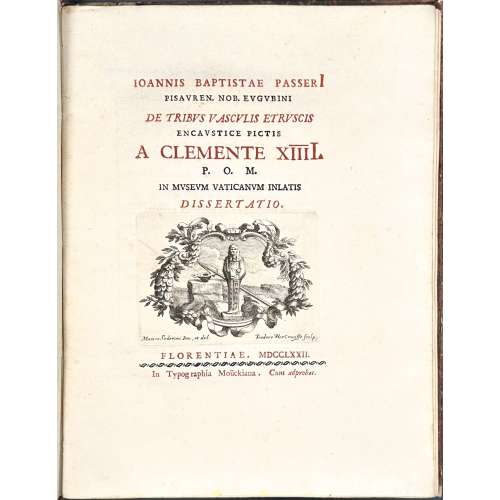 Owner’s wrappers, 28 x 21 cm, printed on laid paper, unpaginated, collated ffl, [A, B]4 C-G4, 2 ffl; total 28 leaves plus 5 engraved plates by Allegrini after Mariotti; engraved title-page (Vercruys after Soderini), head- and tailpieces (Gregori after del Moro) and initials. Owner's label to front pastedown: Marc Burdin, prêtre. Title-page (engraved, red and black): IOANNIS BAPTISTAE PASSERI | PISAUREN. NOB. EUGUBINI | DE TRIBUS VASCULIS ETRUSCIS | ENCAUSTICE PICTIS | A CLEMENTE XIIII. | P.O.M. | IN MUSEUM VATICANUM INLATIS | DISSERTATIO. | {VIGNETTE} | FLORENTIAE. MDCCLXXII. | ~ | in Typographia Moückiana. Cum adprobat. || Dedication: ANTIQVARIAE. ERVDITIONIS. PROPAGATORI EXIMIO ABSOLVTISSIMAM . HANC. DISSERTATIONEM CLARISS. PASSERII DE . IMAGINIBVS . ET . SYMBOLIS TRIVM . VASORVM . ETRVSCI . OPERIS QVAE PRINCIPIS. NOSTRI.SANCTISS. ET. SAPIENTISS. LARGITATE IN . VATICANVM . MVSEVM A. SE. CVMVLATISSIME . DITATVM INVE CTA . FVERVNT REGINALDVS.COMES.ANSIDAEVS.PATR.PERVS. M. A. CARD. PRONEPOS DEVOTVS. NOMINI . MAIESTATIQVE . EIVS DEMISSISSIME. Translation: "To the most excellent promoter of antiquities, the most accomplished: This most complete dissertation concerning the images and symbols of three Etruscan vases, which were most abundantly bestowed by our most holy and wise Prince onto the Vatican museum, was composed by the illustrious Passerius. Reginald, Count of Ansidius, true ancestral father, grandson by blood of the Cardinal, devoted most humbly and devoutly to his name and majesty." Note: P.O.M. stands for "Papa Optimo Maximo", which translates to "Father Most Excellent." For a similar vase in this collection, see VO-0098.
Owner’s wrappers, 28 x 21 cm, printed on laid paper, unpaginated, collated ffl, [A, B]4 C-G4, 2 ffl; total 28 leaves plus 5 engraved plates by Allegrini after Mariotti; engraved title-page (Vercruys after Soderini), head- and tailpieces (Gregori after del Moro) and initials. Owner's label to front pastedown: Marc Burdin, prêtre. Title-page (engraved, red and black): IOANNIS BAPTISTAE PASSERI | PISAUREN. NOB. EUGUBINI | DE TRIBUS VASCULIS ETRUSCIS | ENCAUSTICE PICTIS | A CLEMENTE XIIII. | P.O.M. | IN MUSEUM VATICANUM INLATIS | DISSERTATIO. | {VIGNETTE} | FLORENTIAE. MDCCLXXII. | ~ | in Typographia Moückiana. Cum adprobat. || Dedication: ANTIQVARIAE. ERVDITIONIS. PROPAGATORI EXIMIO ABSOLVTISSIMAM . HANC. DISSERTATIONEM CLARISS. PASSERII DE . IMAGINIBVS . ET . SYMBOLIS TRIVM . VASORVM . ETRVSCI . OPERIS QVAE PRINCIPIS. NOSTRI.SANCTISS. ET. SAPIENTISS. LARGITATE IN . VATICANVM . MVSEVM A. SE. CVMVLATISSIME . DITATVM INVE CTA . FVERVNT REGINALDVS.COMES.ANSIDAEVS.PATR.PERVS. M. A. CARD. PRONEPOS DEVOTVS. NOMINI . MAIESTATIQVE . EIVS DEMISSISSIME. Translation: "To the most excellent promoter of antiquities, the most accomplished: This most complete dissertation concerning the images and symbols of three Etruscan vases, which were most abundantly bestowed by our most holy and wise Prince onto the Vatican museum, was composed by the illustrious Passerius. Reginald, Count of Ansidius, true ancestral father, grandson by blood of the Cardinal, devoted most humbly and devoutly to his name and majesty." Note: P.O.M. stands for "Papa Optimo Maximo", which translates to "Father Most Excellent." For a similar vase in this collection, see VO-0098.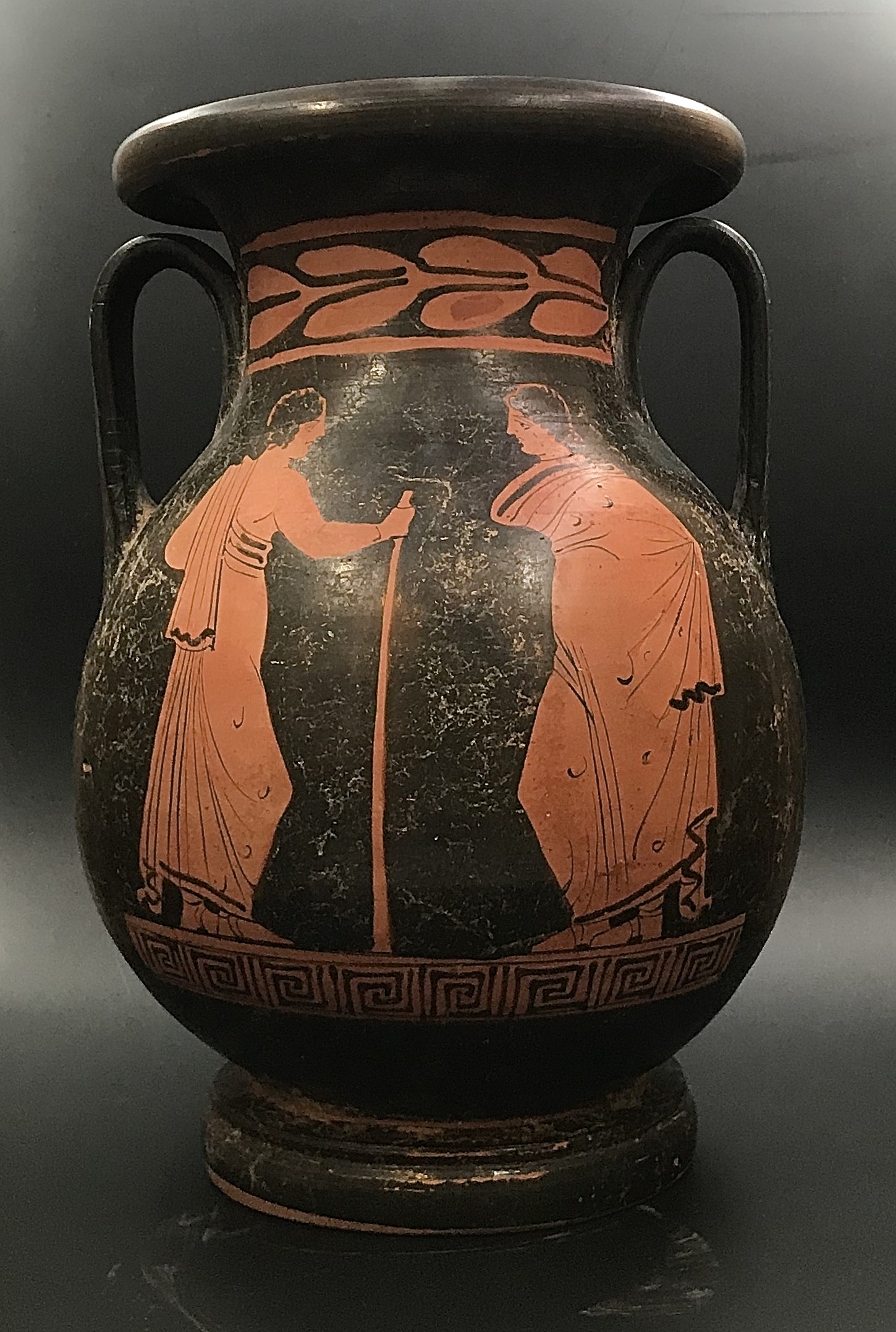
 This vase is attributed to Apulia, ca. 330 BCE. Passeri was probably wrong to attribute this type of vessel to Etruscan vase painting, produced from the 7th through the 4th centuries BC.
Contributors:
Giovanni Battista Passeri (Italian, 1694 – 1780) – author.
Francesco Moücke (Italian, fl. 1729 – 1787) – publisher.
Pope Clement XIV [Ganganelli, Giovanni Vincenzo Antonio] (Italian, 1705 – 1774) – dedicatee.
Artists:
Mauro Soderini (Italian, 1704 – after 1751)
Carlo Spiridione Mariotti (Italian, 1726 – 1790)
Lorenzo del Moro (Italian, 1677 – 1735)
Engravers:
Theodor Vercruys [Teodoro Vercruysse] (Dutch, 1678 – 1739)
Francesco Allegrini da Gubbio (Italian, 1587 – 1663)
Carlo Bartolomeo Gregori (Italian, 1702 – 1759)
This vase is attributed to Apulia, ca. 330 BCE. Passeri was probably wrong to attribute this type of vessel to Etruscan vase painting, produced from the 7th through the 4th centuries BC.
Contributors:
Giovanni Battista Passeri (Italian, 1694 – 1780) – author.
Francesco Moücke (Italian, fl. 1729 – 1787) – publisher.
Pope Clement XIV [Ganganelli, Giovanni Vincenzo Antonio] (Italian, 1705 – 1774) – dedicatee.
Artists:
Mauro Soderini (Italian, 1704 – after 1751)
Carlo Spiridione Mariotti (Italian, 1726 – 1790)
Lorenzo del Moro (Italian, 1677 – 1735)
Engravers:
Theodor Vercruys [Teodoro Vercruysse] (Dutch, 1678 – 1739)
Francesco Allegrini da Gubbio (Italian, 1587 – 1663)
Carlo Bartolomeo Gregori (Italian, 1702 – 1759) -
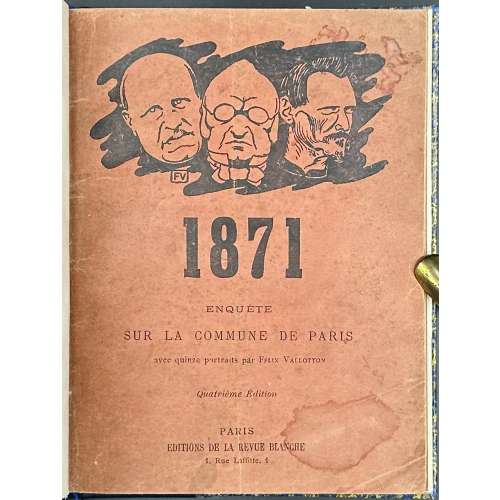 Hardcover, 20.2 x 15.5 cm, owner’s half blue morocco binding over marbled boards with gilt lettering to spine, marbled endpapers, extracts from La Revue Blanche, numbers 91 and 92 of March 15 and April 1 of 1897 (année VII, tome XII), publisher’s pink wrappers preserved, pp. [2] [1-5] 6-160. Ref.: Bridget Alsdorf. Vallotton, Fénéon, and the Legacy of the Commune in Fin-de-siècle France. Portraits: François [Quico] Merlin Colonel Merlin (French, 1814 – 1900) Adolphe Thiers (French, 1797 – 1877) Commandant Gaveau Fortuné Henry (French, 1821 – 1882) Otto von Bismarck (German, 1815 – 1898) Henri, comte de Chambord (French, 1820 – 1883) Louis Rossel (French, 1844 – 1871) François Huet Tranquille (French, 1842 – after 1879) Joseph Vinoy (French, 1803 – 1880) Raoul Rigault (French, 1846 – 1871) Eugène Varlin (French, 1839 – 1871) Théophile Ferré (French, 1845 – 1871) Georges Darboy (French, 1813 – 1871) Auguste Vermorel (French, 1841 – 1871) Jaroslaw Dombrowski [Jarosław Dąbrowski] (Polish-French, 1836 – 1871) Contributors: Félix Fénéon (French, 1861 – 1944) Félix Vallotton (French, 1865 – 1925) La Revue Blanche (Paris) Imprimerie Alcan-Lévy
Hardcover, 20.2 x 15.5 cm, owner’s half blue morocco binding over marbled boards with gilt lettering to spine, marbled endpapers, extracts from La Revue Blanche, numbers 91 and 92 of March 15 and April 1 of 1897 (année VII, tome XII), publisher’s pink wrappers preserved, pp. [2] [1-5] 6-160. Ref.: Bridget Alsdorf. Vallotton, Fénéon, and the Legacy of the Commune in Fin-de-siècle France. Portraits: François [Quico] Merlin Colonel Merlin (French, 1814 – 1900) Adolphe Thiers (French, 1797 – 1877) Commandant Gaveau Fortuné Henry (French, 1821 – 1882) Otto von Bismarck (German, 1815 – 1898) Henri, comte de Chambord (French, 1820 – 1883) Louis Rossel (French, 1844 – 1871) François Huet Tranquille (French, 1842 – after 1879) Joseph Vinoy (French, 1803 – 1880) Raoul Rigault (French, 1846 – 1871) Eugène Varlin (French, 1839 – 1871) Théophile Ferré (French, 1845 – 1871) Georges Darboy (French, 1813 – 1871) Auguste Vermorel (French, 1841 – 1871) Jaroslaw Dombrowski [Jarosław Dąbrowski] (Polish-French, 1836 – 1871) Contributors: Félix Fénéon (French, 1861 – 1944) Félix Vallotton (French, 1865 – 1925) La Revue Blanche (Paris) Imprimerie Alcan-Lévy -
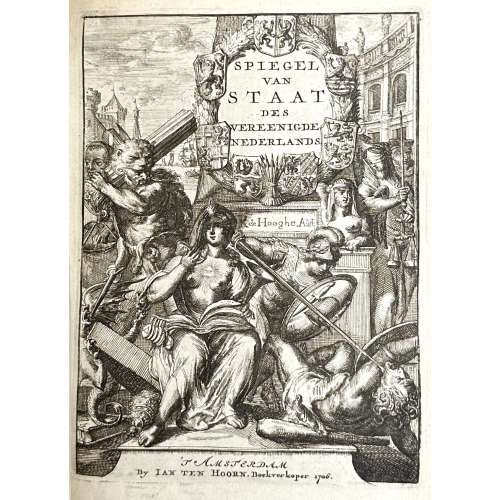 Two hardcover volumes 22.7 x 18.5 x 4.5 cm, uniformly bound in contemporary vellum with a blind border along the edges, handwritten title to spine, printed on laid paper with watermarks to ffls: “Leonard”, “ISRB”, and the arms of Amsterdam. Vol. 1: SPIEGEL van STAAT | des | VEREENIGDE | NEDERLANDS. | Waar in | De Macht en 't Vry Bestier, | Van yder der Zeven Verbonde PROVINCIEN en haar | byzondere Steeden, | Zo in Rechten als Regeeringen werd ontvouwd. | Aanwyzende | Aan, de In, en Uytheemschen, alle de Hooge en Lage Recht- | banken, Collegien en Ampten, dewelke in de zelve, tot | dienst van den Staat, en het Recht, zyn ingesteld. | Hoe, wanneer en waar, voor de zelve yets te verrichten is. | DOOR | Mr: ROMYN de HOOGHE. | EERSTE DEEL: | {fleuron} | t’ AMSTERDAM, | — | By JAN TEN HOORN, Boekverkooper 1706. Collation: 2ffl, *-**4, A-Z4 2A-Z4 3A-O4 4A-G4 5A-S4 6A-F4, 2ffl, (4G2 marked 3G2), total 372 leaves, plus 8 folded leaves of plates, t.p., and half-page vignette dedication by Romeyn de Hooghe. Pagination: [16], 1-267, 268-270 (marked 468-470) 271-480, [2] 3-55 [56], [2] 3-143 [144], [2] 3-44 [4], total 744 pages, ils. Vol. 2: SPIEGEL van STAAT. | VERVATTENDE | DE MACHT DER | GENERALITEYT. | De Edele Mogende Collegiën, | Hooge Rechtbaken, Steden, Schansen | en Onderhoorigheeden, | Welke van Hoog Mogende af angen. | DOOR | Mr: ROMYN de HOOGHE. | TWEEDE DEEL. | Met Figuuren. | {fleuron} | Te AMSTERDAM, | — | By JAN TEN HOORN, | Boekverkooper, 1707. Collation: 2ffl, *-**4, ***2, A-Z4 2A-T4, (A-Z)4, (2A-V)4 X2, 2ffl, total 352 leaves plus 9 folded leaves of plates, t.p., and half-page vignette dedication by Romeyn de Hooghe. Pagination: [20], 1-335 [336], 1-339 [340] [8], total 704 pages, ils. Contributors: Romeyn de Hooghe (Dutch, 1645 – 1708) Jan ten Hoorn (Dutch, fl. 1671 – 1715)
Two hardcover volumes 22.7 x 18.5 x 4.5 cm, uniformly bound in contemporary vellum with a blind border along the edges, handwritten title to spine, printed on laid paper with watermarks to ffls: “Leonard”, “ISRB”, and the arms of Amsterdam. Vol. 1: SPIEGEL van STAAT | des | VEREENIGDE | NEDERLANDS. | Waar in | De Macht en 't Vry Bestier, | Van yder der Zeven Verbonde PROVINCIEN en haar | byzondere Steeden, | Zo in Rechten als Regeeringen werd ontvouwd. | Aanwyzende | Aan, de In, en Uytheemschen, alle de Hooge en Lage Recht- | banken, Collegien en Ampten, dewelke in de zelve, tot | dienst van den Staat, en het Recht, zyn ingesteld. | Hoe, wanneer en waar, voor de zelve yets te verrichten is. | DOOR | Mr: ROMYN de HOOGHE. | EERSTE DEEL: | {fleuron} | t’ AMSTERDAM, | — | By JAN TEN HOORN, Boekverkooper 1706. Collation: 2ffl, *-**4, A-Z4 2A-Z4 3A-O4 4A-G4 5A-S4 6A-F4, 2ffl, (4G2 marked 3G2), total 372 leaves, plus 8 folded leaves of plates, t.p., and half-page vignette dedication by Romeyn de Hooghe. Pagination: [16], 1-267, 268-270 (marked 468-470) 271-480, [2] 3-55 [56], [2] 3-143 [144], [2] 3-44 [4], total 744 pages, ils. Vol. 2: SPIEGEL van STAAT. | VERVATTENDE | DE MACHT DER | GENERALITEYT. | De Edele Mogende Collegiën, | Hooge Rechtbaken, Steden, Schansen | en Onderhoorigheeden, | Welke van Hoog Mogende af angen. | DOOR | Mr: ROMYN de HOOGHE. | TWEEDE DEEL. | Met Figuuren. | {fleuron} | Te AMSTERDAM, | — | By JAN TEN HOORN, | Boekverkooper, 1707. Collation: 2ffl, *-**4, ***2, A-Z4 2A-T4, (A-Z)4, (2A-V)4 X2, 2ffl, total 352 leaves plus 9 folded leaves of plates, t.p., and half-page vignette dedication by Romeyn de Hooghe. Pagination: [20], 1-335 [336], 1-339 [340] [8], total 704 pages, ils. Contributors: Romeyn de Hooghe (Dutch, 1645 – 1708) Jan ten Hoorn (Dutch, fl. 1671 – 1715) -
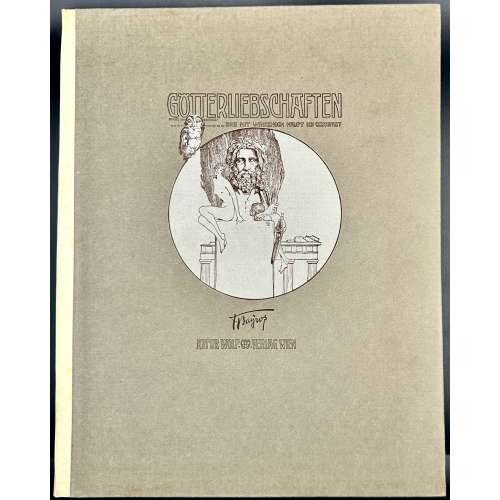 Letterpress title-page, engraved title-page, and 10 sheets of collotype plates printed on india paper mounted on thick wove paper, with captioned guard sheets, loose in a vellum-backed cardboard portfolio with cloth-mounted flaps; floral diaper design inside throughout; bookseller's label to front board verso; limited edition of 550 copies of which this is copy № 103. Dimensions: 338 x 268 mm portfolio; 325 x 260 mm sheet, 225 x 195 mm image. Front board with lettering and vignette: GÖTTERLIEBSCHAFTEN | DAS MIT WINKENDEM HAUPT ICH GEWAHRET | {vignette} | {signature} | ARTUR WOLF / VERLAG WIEN || Letterpress title-page: FRANZ VON BAYROS | “GÖTTERLIEBSCHAFTEN” | ARTUR WOLF / VERLAG WIEN | 1914 || Verso to letterpress t.p. VERZEICHNIS DER TAFELN.
Letterpress title-page, engraved title-page, and 10 sheets of collotype plates printed on india paper mounted on thick wove paper, with captioned guard sheets, loose in a vellum-backed cardboard portfolio with cloth-mounted flaps; floral diaper design inside throughout; bookseller's label to front board verso; limited edition of 550 copies of which this is copy № 103. Dimensions: 338 x 268 mm portfolio; 325 x 260 mm sheet, 225 x 195 mm image. Front board with lettering and vignette: GÖTTERLIEBSCHAFTEN | DAS MIT WINKENDEM HAUPT ICH GEWAHRET | {vignette} | {signature} | ARTUR WOLF / VERLAG WIEN || Letterpress title-page: FRANZ VON BAYROS | “GÖTTERLIEBSCHAFTEN” | ARTUR WOLF / VERLAG WIEN | 1914 || Verso to letterpress t.p. VERZEICHNIS DER TAFELN.- Europa und der Stier
- Leda und die Schildkröte
- Sterope und Herkules
- Herodikos und die Turnerinnen
- Phoroneus und die Hirtin
- Minos und Persipeia
- Phryne und Mutter
- Pytalos und Demeter
- Kirke und die Ferkel
- Putiphar
-
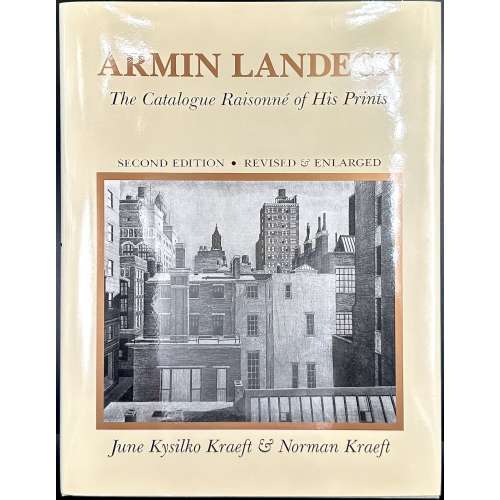 Hardcover volume 28.5 x 22.2 cm, bound in grey cloth with gilt lettering to front and spine, olive endpapers, pictorial dust jacket [Washington square vista] with text and portrait of the authors to flaps, pp.: [i-viii] ix-xxi [xxii], [2] 3-208 [2], total 117 leaves, 205 photomechanical illustrations, limitation to last page: 1200 copies regular edition, 100 copies deluxe edition. Title-page: Armin Landeck | The Catalogue Raisonné of His Prints | Second Edition, Revised and Enlarged | June Kysilko Kraeft and Norman Kraeft | Southern Illinois University Press / Carbondale and Edwardsville || Contributors: Armin Landeck (American, 1905 – 1984) June Kysilko Kraeft Norman Kraeft
Hardcover volume 28.5 x 22.2 cm, bound in grey cloth with gilt lettering to front and spine, olive endpapers, pictorial dust jacket [Washington square vista] with text and portrait of the authors to flaps, pp.: [i-viii] ix-xxi [xxii], [2] 3-208 [2], total 117 leaves, 205 photomechanical illustrations, limitation to last page: 1200 copies regular edition, 100 copies deluxe edition. Title-page: Armin Landeck | The Catalogue Raisonné of His Prints | Second Edition, Revised and Enlarged | June Kysilko Kraeft and Norman Kraeft | Southern Illinois University Press / Carbondale and Edwardsville || Contributors: Armin Landeck (American, 1905 – 1984) June Kysilko Kraeft Norman Kraeft -
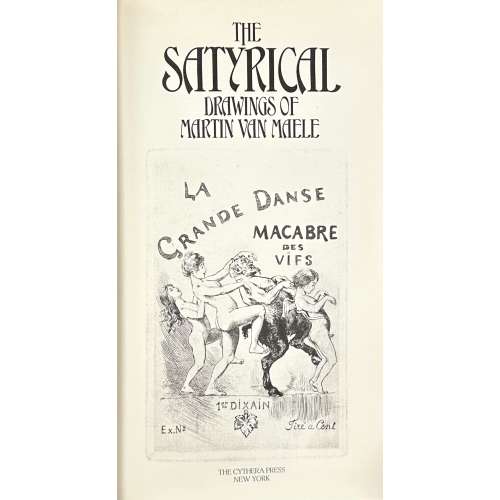 Hardcover volume 28.5 x 19 cm, bound in brown wrinkled buckram with framed gilt lettering and fleurons to front and framed gilt lettering to spine, in a pictorial dust jacket, green and yellow floral diaper endpapers, printed on laid paper, bottom and outer margins untrimmed. Collation: Eight unnumbered pages of text in English, incl. bibliography, plus 45 unnumbered leaves of plates (photomechanical) with captions in French. Facsimile reproduction of the published in ca. 1907-1908 ‘La grande danse macabre des vifs’, which can be loosely translated as ‘The great strange dance of life’ or ‘The great dance of death by the living’. Title-page: THE | SATYRICAL | DRAWINGS OF | MARTIN VAN MAELE | {vignette} | THE CYTHERA PRESS NEW YORK || SELECTED BIBLIOGRAPHY OF MAURICE FRANÇOIS ALFRED MARTIN VAN MAËLE [MARTIN VAN MAËLE] (FRENCH, 1863 – 1926) (ANONYMOUS). Sweet Seventeen. — Paris: Charles Carrington, 1910. ANSON, MARGUERITE. Une Société de flagellantes. — Paris: Charles Carrington. 1902. 31 illustrations by Van Maele and A. Lambrecht. Translation of The Merry Order of St. Bridget. APULEUS, LUCIUS. Les Métamorphoses, ou l’âne d'or. — Paris: Charles Carrington, 1905. Translation of The Golden Ass. The same Van Maele plates were probably used by the publisher for his English translation of the same work (Paris, 1904). ARETINO, PIETRO. Les Dialogues. 2 volumes. — Paris: Au Cabinet du Livre. 1927. Only the textual illustrations are by Van Maele. The other plates are by Viset. This is believed to be the Iast book that Van Maele illustrated. DESROIX, JACQUES. La Gynécocratte. — Paris: Charles Carrington, 1902. Translation of Gynecocracy. FRANCE, ANATOLE. Thaïs. — Paris: Charles Carrington, 1901. English translation. JUSANGE. PIERRE DE. La Comtesse au foulet. — Paris: Collection des Orties Blanches, s.d. SACHER-MASOCH. La Vénus a la fourrure. — Paris: Charles Carrington, 1902. VAN MAELE, MARTIN. La Grande Danse macabre des vifs. — Paris: Charles Carrington, ca. 1907-8. VERLAINE, PAUL. La Trilogie érotique. — Paris: Charles Carrington, 1907. Reprinted, Brussels, 1931. The original edition is rare. VILLIOT, JEAN DE. Camille et moi. — Paris: Charles Carrington, 1904. Translation of Frank and I. VILLIOT, JEAN DE. Dix-sept ans. — Paris: Librairie des Bibliophiles Parisiens, Charles Carrington, 1905. Translation of Sweet Seventeen. VILLIOT, JEAN DE. La Flagellation amoureuse. — Paris: Charles Carrington. 1904. VILLIOT, JEAN DE. La Flagellation des femmes en Allemagne. — Paris: Charles Carrington. 1901. Translation of Nell in Bridewell. VILLIOT, JEAN DE. Volées de bois vert. — Paris: Librairie des Bibliophiles Parisiens, Charles Carrington, 1905. (ANONYMOUS): Flèches de plomb. BAUDELAIRE, CHARLES. Les Fleurs du mal. BERANGER. Chansons érotiques. CHODER LOS DE LACLOS. Les Liaisons dangereuses. — Paris: 1908. GAUTIER, THEOPHILE. Lettre au Président. HARAUCOURT. Légende des sexes. — Paris, 1908. MICHELET, JULES. La Sorcière. — Paris, 1911.
Hardcover volume 28.5 x 19 cm, bound in brown wrinkled buckram with framed gilt lettering and fleurons to front and framed gilt lettering to spine, in a pictorial dust jacket, green and yellow floral diaper endpapers, printed on laid paper, bottom and outer margins untrimmed. Collation: Eight unnumbered pages of text in English, incl. bibliography, plus 45 unnumbered leaves of plates (photomechanical) with captions in French. Facsimile reproduction of the published in ca. 1907-1908 ‘La grande danse macabre des vifs’, which can be loosely translated as ‘The great strange dance of life’ or ‘The great dance of death by the living’. Title-page: THE | SATYRICAL | DRAWINGS OF | MARTIN VAN MAELE | {vignette} | THE CYTHERA PRESS NEW YORK || SELECTED BIBLIOGRAPHY OF MAURICE FRANÇOIS ALFRED MARTIN VAN MAËLE [MARTIN VAN MAËLE] (FRENCH, 1863 – 1926) (ANONYMOUS). Sweet Seventeen. — Paris: Charles Carrington, 1910. ANSON, MARGUERITE. Une Société de flagellantes. — Paris: Charles Carrington. 1902. 31 illustrations by Van Maele and A. Lambrecht. Translation of The Merry Order of St. Bridget. APULEUS, LUCIUS. Les Métamorphoses, ou l’âne d'or. — Paris: Charles Carrington, 1905. Translation of The Golden Ass. The same Van Maele plates were probably used by the publisher for his English translation of the same work (Paris, 1904). ARETINO, PIETRO. Les Dialogues. 2 volumes. — Paris: Au Cabinet du Livre. 1927. Only the textual illustrations are by Van Maele. The other plates are by Viset. This is believed to be the Iast book that Van Maele illustrated. DESROIX, JACQUES. La Gynécocratte. — Paris: Charles Carrington, 1902. Translation of Gynecocracy. FRANCE, ANATOLE. Thaïs. — Paris: Charles Carrington, 1901. English translation. JUSANGE. PIERRE DE. La Comtesse au foulet. — Paris: Collection des Orties Blanches, s.d. SACHER-MASOCH. La Vénus a la fourrure. — Paris: Charles Carrington, 1902. VAN MAELE, MARTIN. La Grande Danse macabre des vifs. — Paris: Charles Carrington, ca. 1907-8. VERLAINE, PAUL. La Trilogie érotique. — Paris: Charles Carrington, 1907. Reprinted, Brussels, 1931. The original edition is rare. VILLIOT, JEAN DE. Camille et moi. — Paris: Charles Carrington, 1904. Translation of Frank and I. VILLIOT, JEAN DE. Dix-sept ans. — Paris: Librairie des Bibliophiles Parisiens, Charles Carrington, 1905. Translation of Sweet Seventeen. VILLIOT, JEAN DE. La Flagellation amoureuse. — Paris: Charles Carrington. 1904. VILLIOT, JEAN DE. La Flagellation des femmes en Allemagne. — Paris: Charles Carrington. 1901. Translation of Nell in Bridewell. VILLIOT, JEAN DE. Volées de bois vert. — Paris: Librairie des Bibliophiles Parisiens, Charles Carrington, 1905. (ANONYMOUS): Flèches de plomb. BAUDELAIRE, CHARLES. Les Fleurs du mal. BERANGER. Chansons érotiques. CHODER LOS DE LACLOS. Les Liaisons dangereuses. — Paris: 1908. GAUTIER, THEOPHILE. Lettre au Président. HARAUCOURT. Légende des sexes. — Paris, 1908. MICHELET, JULES. La Sorcière. — Paris, 1911. -
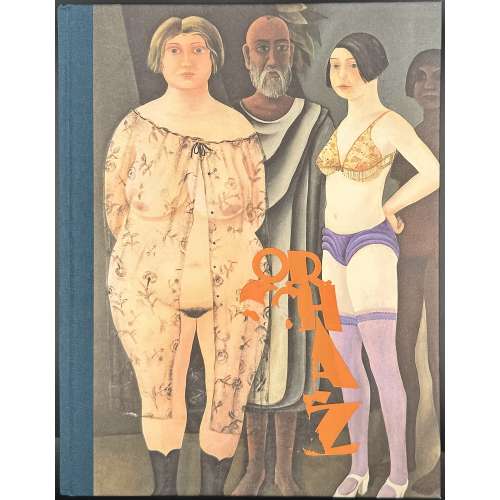 Hardcover, 31 x 24 cm, blue cloth over cardboard, orange lettering to spine, pictorial front cover, embossed back cover, pp.: [1-6] 7-271 [1], approx. 700 colour illustrations. Monograph and catalogue raisonné. ISBN: 978-3-85415-570-6. Title-page (orange): CORNELIA CABUK | {O. R. Schatz as vignette} | MONOGRAFIE | und | WERK= | VERZEICHNIS | mit Textbeiträgen von | STELLA ROLLIG | DIETER KRAFT | CORNELIA CABUK | Belvedere Werkverzeichnisse, Band 7 | Stella Rollig, Christian Huemer (Hg.) || Contributors: Otto Rudolf Schatz (Austrian, 1900 – 1961) Österreichische Galerie Belvedere Cornelia Cabuk Dieter Kraft Stella Rollig Ritter Verlag (Vienna)
Hardcover, 31 x 24 cm, blue cloth over cardboard, orange lettering to spine, pictorial front cover, embossed back cover, pp.: [1-6] 7-271 [1], approx. 700 colour illustrations. Monograph and catalogue raisonné. ISBN: 978-3-85415-570-6. Title-page (orange): CORNELIA CABUK | {O. R. Schatz as vignette} | MONOGRAFIE | und | WERK= | VERZEICHNIS | mit Textbeiträgen von | STELLA ROLLIG | DIETER KRAFT | CORNELIA CABUK | Belvedere Werkverzeichnisse, Band 7 | Stella Rollig, Christian Huemer (Hg.) || Contributors: Otto Rudolf Schatz (Austrian, 1900 – 1961) Österreichische Galerie Belvedere Cornelia Cabuk Dieter Kraft Stella Rollig Ritter Verlag (Vienna) -
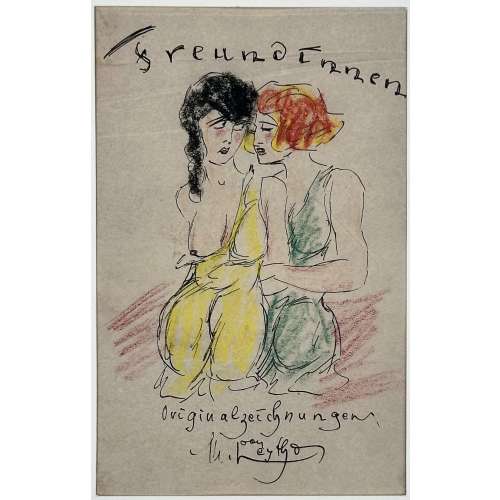 Seven pen and ink and colour crayon drawings on thin wove paper approx. 140 x 100 mm, each attached to a sheet 310 x 240 mm and mounted in a passepartout, placed in an aubergine cardboard folder 310 x 250 mm with a tan vellum spine and paper flaps inside; olive label with double border and gilt lettering to front cover "Dessins" [Drawings]. The first sheet is a title-page lettered in manuscript: Freundinnen | {vignette} | Originalzeichnungen | M. Leytho || [Girlfriends. Original drawings]. Information about the artist at www.honesterotica.com: "Mitja Leytho, almost certainly a pseudonym, is yet another mediocre yet fascinating amateur artist from the Germany of the 1920s about whom we know absolutely nothing beyond the four portfolios which bear the ‘Leytho’ signature". We shall notice that this set of drawings was produced by a talented professional, not an amateur.
Seven pen and ink and colour crayon drawings on thin wove paper approx. 140 x 100 mm, each attached to a sheet 310 x 240 mm and mounted in a passepartout, placed in an aubergine cardboard folder 310 x 250 mm with a tan vellum spine and paper flaps inside; olive label with double border and gilt lettering to front cover "Dessins" [Drawings]. The first sheet is a title-page lettered in manuscript: Freundinnen | {vignette} | Originalzeichnungen | M. Leytho || [Girlfriends. Original drawings]. Information about the artist at www.honesterotica.com: "Mitja Leytho, almost certainly a pseudonym, is yet another mediocre yet fascinating amateur artist from the Germany of the 1920s about whom we know absolutely nothing beyond the four portfolios which bear the ‘Leytho’ signature". We shall notice that this set of drawings was produced by a talented professional, not an amateur. -
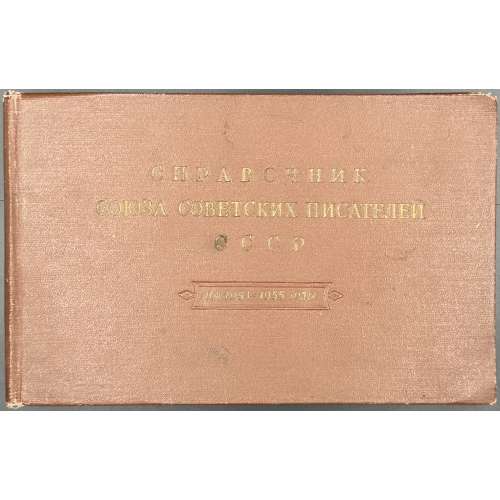 Oblong hardcover volume, 13.3 x 21 cm, bound in brown buckram with embossed gilt lettering to front, pp.: [1-4] 5-482 [2] errata leaf tipped-in. Title-page: СОЮЗ СОВЕТСКИХ ПИСАТЕЛЕЙ СССР | СПРАВОЧНИК | на 1954 — 1955 годы | ИЗДАТЕЛЬСТВО «Советский писатель» | МОСКВА 1954 || On page 71, second from bottom: Варшавский Сергей Петрович, г. Ленинград, Ропшинская ул., д. 1/32, кв. 18, тел. В 3-56-00. Print run: 3,000 copies.
Oblong hardcover volume, 13.3 x 21 cm, bound in brown buckram with embossed gilt lettering to front, pp.: [1-4] 5-482 [2] errata leaf tipped-in. Title-page: СОЮЗ СОВЕТСКИХ ПИСАТЕЛЕЙ СССР | СПРАВОЧНИК | на 1954 — 1955 годы | ИЗДАТЕЛЬСТВО «Советский писатель» | МОСКВА 1954 || On page 71, second from bottom: Варшавский Сергей Петрович, г. Ленинград, Ропшинская ул., д. 1/32, кв. 18, тел. В 3-56-00. Print run: 3,000 copies. -
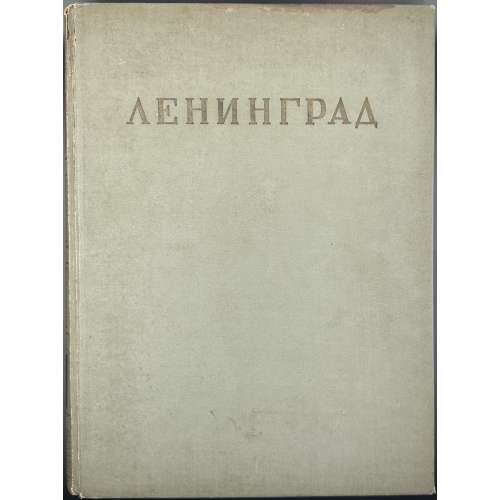 Hardcover volume 36 x 27.5 cm, bound in grey cloth, gilt lettering ЛЕНИНГРАД to front board, red and black labels with gilt lettering, gilt compartments to flat spine, red endpapers with black and white border, pp.: [1-6] 7-402 [2], total 202 leaves with numerous b/w illustrations, plus frontispiece with pasted in b/w plate. Bookplate of Feodor Rojankovsky to front pastedown, ms inscription: “Дорогой Федя, дарю Вам на Ваше рождение эту книгу” signed “Ф. Рожанковский” Half-title (red on tan): ИЗДАНО В ЛЕНИНГРАДЕ | В ДНИ ВЕЛИКОЙ | ОТЕЧЕСТВЕННОЙ ВОЙНЫ || Half-title verso (red on tan): ЛЕНИНГРАДСКИЙ ГОРОДСКОЙ СОВЕТ | ДЕПУТАТОВ ТРУДЯЩИХСЯ | ИСПОЛНИТЕЛЬНЫЙ КОМИТЕТ | {vignette «plan»} | АРХИТЕКТУРНО-ПЛАНИРОВОЧНОЕ | УПРАВЛЕНИЕ | 1943 || Title-page (red on tan) ЛЕНИНГРАД | {vignette «Admiralty»} | ГОСУДАРСТВЕННОЕ ИЗДАТЕЛЬСТВО | «ИСКУССТВО» | ЛЕНИНГРАД – 1943 – МОСКВА || Blue ink stamp to bottom right: Printed in Soviet Union. Title-page verso: РЕДАКЦИОННАЯ | КОЛЛЕГИЯ | Ответственный редактор | БАРАНОВ Н. В. | КАМЕНСКИЙ В. А. | МОРОЗОВ М. В. | РУБАНЕНКО Б. Р. | ФОМИН И. И. | Художник издания | КАМЕНСКИЙ В. А. | Технический редактор | АНИСИМОВ М. Н. Contents (red on tan): АРХИТЕКТУРНО-ПЛАНИРОВОЧНЫЙ | ОБЗОР РАЗВИТИЯ ГОРОДА | РАЗВИТИЕ ГОРОДА В XVIII ВЕКЕ | С. М. ЗЕМЦОВ | РАЗВИТИЕ ГОРОДА В XIX ВЕКЕ | А. Г. ЯЦЕВИЧ | РАЗВИТИЕ ГОРОДА С 1917 ПО 1935 г. | Б. Р. РУБАНЕНКО | ГЕНЕРАЛЬНЫЙ ПЛАН РАЗВИТИЯ | ЛЕНИНГРАДА | Н. В. БАРАНОВ | ИЛЛЮСТРАЦИИ | ГОРОДА || verso: {vignette} | ГЕНЕРАЛЬНЫЙ ПЛАН ГОРОДА ЛЕНИНГРАДА. || Print run: 2,500 copies. Provenance: Feodor Rojankovsky [Rojan, Фёдор Степанович Рожанковский] (Russian-American, 1891 – 1970). Contributors: Каменский, Валентин Александрович (Russian, 1907 – 1975) Земцов, Станислав [Исай] Маркович (1906 – ?) Яцевич, Андрей Григорьевич (Russian, 1887 – 1942) Рубаненко, Борис Рафаилович (Russian-Jewish, 1910 – 1985) Баранов, Николай Варфоломеевич (Russian, 1909 – 1989) Фомин, Игорь Иванович (Russian, 1904 – 1989)
Hardcover volume 36 x 27.5 cm, bound in grey cloth, gilt lettering ЛЕНИНГРАД to front board, red and black labels with gilt lettering, gilt compartments to flat spine, red endpapers with black and white border, pp.: [1-6] 7-402 [2], total 202 leaves with numerous b/w illustrations, plus frontispiece with pasted in b/w plate. Bookplate of Feodor Rojankovsky to front pastedown, ms inscription: “Дорогой Федя, дарю Вам на Ваше рождение эту книгу” signed “Ф. Рожанковский” Half-title (red on tan): ИЗДАНО В ЛЕНИНГРАДЕ | В ДНИ ВЕЛИКОЙ | ОТЕЧЕСТВЕННОЙ ВОЙНЫ || Half-title verso (red on tan): ЛЕНИНГРАДСКИЙ ГОРОДСКОЙ СОВЕТ | ДЕПУТАТОВ ТРУДЯЩИХСЯ | ИСПОЛНИТЕЛЬНЫЙ КОМИТЕТ | {vignette «plan»} | АРХИТЕКТУРНО-ПЛАНИРОВОЧНОЕ | УПРАВЛЕНИЕ | 1943 || Title-page (red on tan) ЛЕНИНГРАД | {vignette «Admiralty»} | ГОСУДАРСТВЕННОЕ ИЗДАТЕЛЬСТВО | «ИСКУССТВО» | ЛЕНИНГРАД – 1943 – МОСКВА || Blue ink stamp to bottom right: Printed in Soviet Union. Title-page verso: РЕДАКЦИОННАЯ | КОЛЛЕГИЯ | Ответственный редактор | БАРАНОВ Н. В. | КАМЕНСКИЙ В. А. | МОРОЗОВ М. В. | РУБАНЕНКО Б. Р. | ФОМИН И. И. | Художник издания | КАМЕНСКИЙ В. А. | Технический редактор | АНИСИМОВ М. Н. Contents (red on tan): АРХИТЕКТУРНО-ПЛАНИРОВОЧНЫЙ | ОБЗОР РАЗВИТИЯ ГОРОДА | РАЗВИТИЕ ГОРОДА В XVIII ВЕКЕ | С. М. ЗЕМЦОВ | РАЗВИТИЕ ГОРОДА В XIX ВЕКЕ | А. Г. ЯЦЕВИЧ | РАЗВИТИЕ ГОРОДА С 1917 ПО 1935 г. | Б. Р. РУБАНЕНКО | ГЕНЕРАЛЬНЫЙ ПЛАН РАЗВИТИЯ | ЛЕНИНГРАДА | Н. В. БАРАНОВ | ИЛЛЮСТРАЦИИ | ГОРОДА || verso: {vignette} | ГЕНЕРАЛЬНЫЙ ПЛАН ГОРОДА ЛЕНИНГРАДА. || Print run: 2,500 copies. Provenance: Feodor Rojankovsky [Rojan, Фёдор Степанович Рожанковский] (Russian-American, 1891 – 1970). Contributors: Каменский, Валентин Александрович (Russian, 1907 – 1975) Земцов, Станислав [Исай] Маркович (1906 – ?) Яцевич, Андрей Григорьевич (Russian, 1887 – 1942) Рубаненко, Борис Рафаилович (Russian-Jewish, 1910 – 1985) Баранов, Николай Варфоломеевич (Russian, 1909 – 1989) Фомин, Игорь Иванович (Russian, 1904 – 1989) -
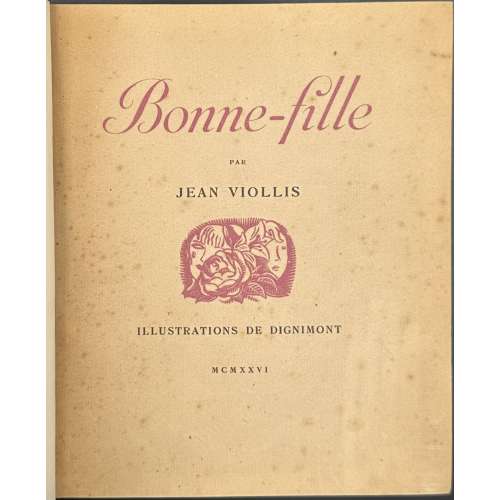 Hardcover volume, 22.5 x 19.5 cm, collated 4to, owner’s terracotta cloth with gilt-lettered black label to spine, publisher’s wrappers preserved, pp.:3 ffl, front wrapper, 3 ffl, [2] h.t./limit, [2] t.p./blank, 1-228 [2] 3 ffl, back wrapper, 3 ffl. Collation: π3 1-314 323. (130 leaves, incl. plates). Title-page (pink and black): Bonne-fille | PAR | JEAN VIOLLIS | Illustrations de | DIGNIMONT | {vignette} | A PARIS | La Collection Originale | ÉDITIONS MORNAY | 37, BOULEVARD DU MONTPARNASSE | MCMXXVI || Illustrations: 14 full-page colour plates, incl. frontispiece and endpiece, within collation but not within pagination, verso blank, and numerous head- and tailpieces and in-text stencil-coloured (au pochoir) lithography after André Dignimont. Limitation: A print run of 628 copies for sale, of which 18 on Japon Ancien, 30 on Japon Impérial, 90 on Hollande, 490 on Rives (139-628), plus 50 copies not for sale. Printed on May 12, 1926, at l’Imprimerie Kapp (Vanves), this copy is № 380. Provenance: Feodor Rojankovsky, pictorial bookplate “ИЗ КНИГ РОЖАНКОВСКАГО” to front pastedown, ms inscription to front ffl2 top “TH. ROJANKOWSKY | 14 VIII 30” in block letters. One of the possible transliterations of Feodor Rojankovsky's name is Theodor Rojankowsky. Contributors: Jean-Henri d'Ardenne deTizac [JeanViollis] (French, 1877 – 1932) – author. André Dignimont (French, 1891 – 1965) – artist. Frédéric Emile Kapp (French, 1851-193?) – printer. Georges Mornay (French, 1876 – 1935) et Antoinette Mornay – pubishers. Feodor Rojankovsky [Rojan; Фёдор Степанович Рожанковский] (Russian-American, 1891 – 1970) – provenance.
Hardcover volume, 22.5 x 19.5 cm, collated 4to, owner’s terracotta cloth with gilt-lettered black label to spine, publisher’s wrappers preserved, pp.:3 ffl, front wrapper, 3 ffl, [2] h.t./limit, [2] t.p./blank, 1-228 [2] 3 ffl, back wrapper, 3 ffl. Collation: π3 1-314 323. (130 leaves, incl. plates). Title-page (pink and black): Bonne-fille | PAR | JEAN VIOLLIS | Illustrations de | DIGNIMONT | {vignette} | A PARIS | La Collection Originale | ÉDITIONS MORNAY | 37, BOULEVARD DU MONTPARNASSE | MCMXXVI || Illustrations: 14 full-page colour plates, incl. frontispiece and endpiece, within collation but not within pagination, verso blank, and numerous head- and tailpieces and in-text stencil-coloured (au pochoir) lithography after André Dignimont. Limitation: A print run of 628 copies for sale, of which 18 on Japon Ancien, 30 on Japon Impérial, 90 on Hollande, 490 on Rives (139-628), plus 50 copies not for sale. Printed on May 12, 1926, at l’Imprimerie Kapp (Vanves), this copy is № 380. Provenance: Feodor Rojankovsky, pictorial bookplate “ИЗ КНИГ РОЖАНКОВСКАГО” to front pastedown, ms inscription to front ffl2 top “TH. ROJANKOWSKY | 14 VIII 30” in block letters. One of the possible transliterations of Feodor Rojankovsky's name is Theodor Rojankowsky. Contributors: Jean-Henri d'Ardenne deTizac [JeanViollis] (French, 1877 – 1932) – author. André Dignimont (French, 1891 – 1965) – artist. Frédéric Emile Kapp (French, 1851-193?) – printer. Georges Mornay (French, 1876 – 1935) et Antoinette Mornay – pubishers. Feodor Rojankovsky [Rojan; Фёдор Степанович Рожанковский] (Russian-American, 1891 – 1970) – provenance. -
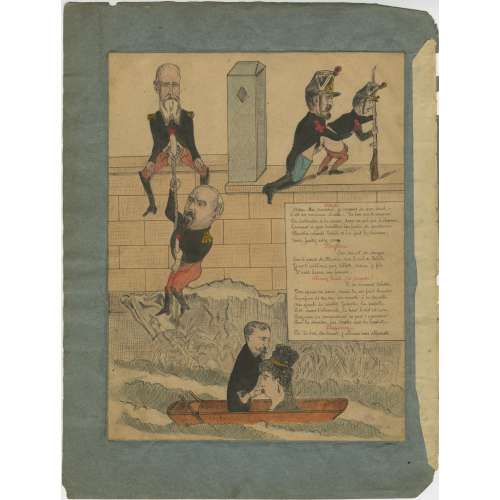 A series of seven political caricatures with indecent content, ink and pigment on paper, bound in a grey-blue folder. Each drawing is pasted to a grey-blue sheet of paper 32 x 24 cm. PLATES: 1) Villette; Bazaine; Alvarez Rull: 250 x 192 mm
A series of seven political caricatures with indecent content, ink and pigment on paper, bound in a grey-blue folder. Each drawing is pasted to a grey-blue sheet of paper 32 x 24 cm. PLATES: 1) Villette; Bazaine; Alvarez Rull: 250 x 192 mm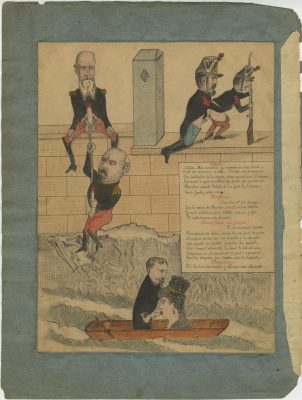
Villette Adieu, cher maréchal, je réponds de mon dard C’est un morceau d’acier… Là bas, sur le rempart, Sa cartouche à la main, dans un cul qui le charme, Lançant à gros bouillons son foutre de gendarme Plantin plante Delille et lui font le Caisson. Bazaine Sur ton vit de dragon Sur le nœud de Plantin, sur le cul de Delille, Je ne t’oublierai pas, Villette, adieu, je file Et je vais baiser ma femme. Alvarez Rull (à Josépha) Il ne saurait tarder, Ton epoux va venir, mais tu me fais bander, Le parfum de ton con me monte à la cervelle, Ma gaule se raidit . Josépha, la nacelle Est dans l’ obscurité, là haut, le ciel est noir, Bazaine en descendant ne peut t’ apercevoir … Pour la dernière fois, torche moi la houlette. Bazaine Eh ! là bas, du canot, j’allume une allumette!
Villette Farewell, dear Marshal, I vouch for my dick. It’s like a steel rod … Over there, on the ramparts, Plantin, his dick in hand, pounds Delisle’s beckoning ass And fills it with his bubbling gendarme’s cum. Bazaine For your dragoon’s dick, For Plantin's prick, for Delisle's ass, I won't forget you, Villette, goodbye, I'm leaving And I'm going to fuck my wife. Alvarez Rull (to Josépha) Hurry up, Your husband is coming, but I got a hard on you, The scent of your cunt penetrates my brain, My rod stiffened. Josépha, the gondola Is in the dark, the sky is black, Bazaine coming down and cannot see you... Give me one last blowjob.Bazaine Hey! Over there, from the canoe, I light a match!
French marshal Achille Bazaine capitulated to Bismarck during the Franco-Prussian war on 27 October 1870. In 1873, he was tried for treason and received a death sentence, later commuted to 20 years' imprisonment. Bazaine was incarcerated in the Fort Royal on Île Sainte-Marguerite, from which he escaped on August 9–10, 1874, with the help of Colonel Villette [Willette], his wife Josefa [Pepita Peña], and her nephew Alvarez Rull. They sailed to Genoa in Italy and from there to London. Plantin and Delisle were prison guards. The story was described in detail during the Trial of Col. Villette and his Accomplices in 1874 and published later in Robert Christophe. La Vie tragique du maréchal Bazaine. — Paris: Vautrain Jacques, 1947.
2) Impératrice Eugénie: 218 x 165 mm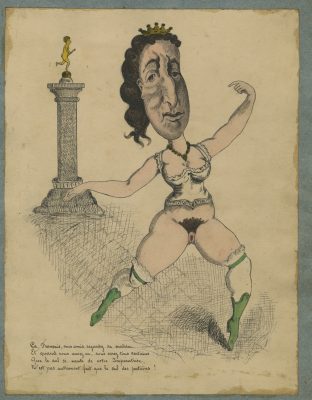
Ça, Français, mes amis, regardez sa matrice, Et quand vous aurez vu, vous serez tous certains Que le cul si vanté de votre Impératrice, N’est pas autrement fait que le cul des putains!
That, French, my friends, look at her cunt, And when you have seen, you will all be certain That the so acclaimed ass of your Empress, Is no different than the ass of whores! 3) Napoléon III: 215 x 168 mm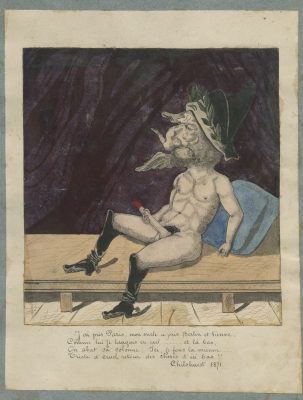
J’ai pris Paris, mon oncle a pris Berlin et Vienne. Comme lui je languis en exil …… et là bas, On abat sa colonne; Ici, je fous la mienne…. Triste et cruel retour des choses d’ici bas!! Chilshurst 1871. [i.e. Chislehurst]
I took Paris, my uncle took Berlin and Vienna. Like him, I, too, languish in exile. His column there was demolished; I’m jerking mine off here…. Cruel and sorrowful deeds!! 4) La confession: 216 x 168 mm (Georges Darboy?)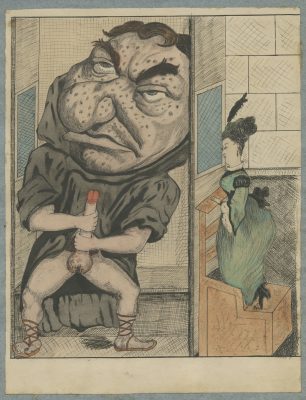 5) Napoléon III et Thérèsa (chanteuse Désirée Emma Valladon): 216 x 176 mm
5) Napoléon III et Thérèsa (chanteuse Désirée Emma Valladon): 216 x 176 mm
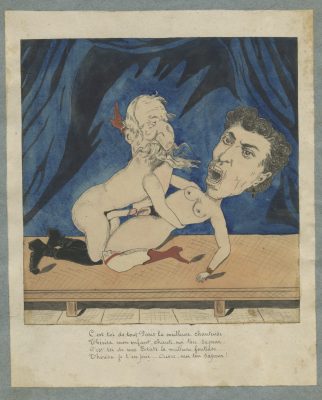
C’est toi de tout Paris la meilleure chanteuse, Thérèsa mon enfant, chante-moi ton sapeur. C’est toi de mes Etats la meilleure fonteuse.. Thérèsa je t’en prie … Ouvre-moi ton sapeur!
You, the best singer in all of Paris, Teresa, my child, sing for me where to insert. You are the best padding in my entire country… Teresa, please... Open your slit for me! 6) Thiers: 219 x 168 mm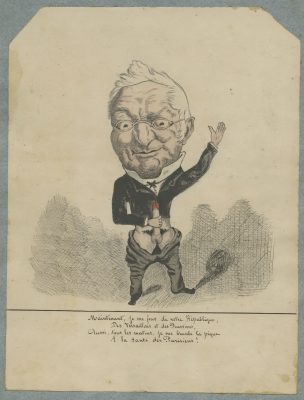
Maintenant, je me fous de votre République, Des Versaillais et des Prussiens, Aussi, tous les matins, je me branle la pique A la santé des Parisiens!
Yes, I don’t care about your Republic now, About Versailles and the Prussians, And every morning I jerk off For the health of Parisians! 7) Émile Ollivier/Rochefort/Jules Favre/Gambetta : 212 x 168 mm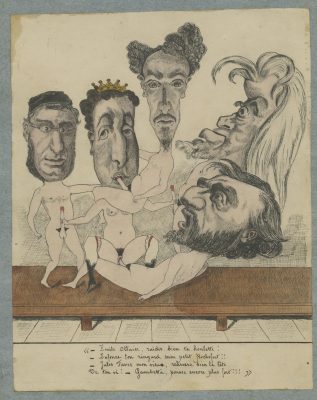
« — Emile Ollivier, raidis bien la houlette! — Enfonce ton ringard mon petit Rochefort!! — Jules Favre mon vieux, redresse bien la tête De ton vi! — Gambetta, pousse encore plus fort!!! »
Emile Ollivier, tighten your dick! - Stick in your poker, my little Rochefort!! - Jules Favre, old man, straighten your dickhead Damn it! – Gambetta, push even harder!!!Characters: Bazaine, François Achille (French, 1811 – 1888) Darboy, Georges (French, 1813 – 1871) Favre, Jules (French, 1809 – 1880) Gambetta, Léon (French, 1838 – 1882) Montijo, Eugénie de (Spanish-French, 1826 – 1920) Napoleon III [Bonaparte, Charles-Louis Napoléon] (French, 1808 – 1873) Ollivier, Émile (French, 1825 – 1913) Peña Azcárate, Josefa [Peña, Pepita] (Mexican-French, 1847 – 1900); Alvarez Rull – nephew of Josefa Peña Azcárate. Rochefort, Henri (French, 1831 – 1913) Thérésa [Valladon, Désirée Emma] (French, 1836 – 1913) Thiers, Adolphe (French, 1797 – 1877)
-
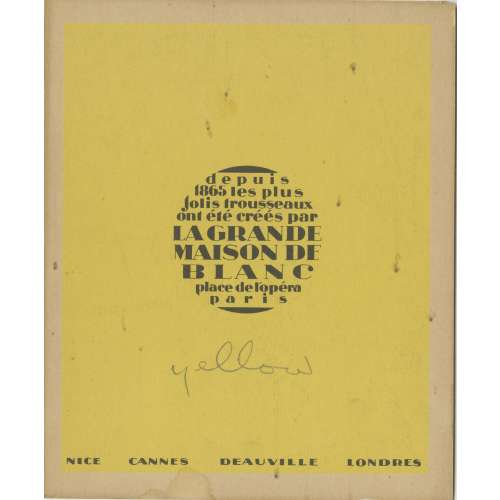 Four chromolithographic plates, each sheet 180 x 150 mm; image 16 x 12.5 cm after Feodor Rojankovsky, signed “Rojan”, titles printed on the back on red (à la chasse), blue (en voyage), green (aux courses), and yellow (depuis | 1865 les plus | jolis trousseaux | ont été créés par | LA GRANDE | MAISON DE | BLANC | place de l’opera | Paris | NICE CANNES DEAUVILLE LONDRES) background. Contributors: Feodor Rojankovsky [Rojan, Фёдор Степанович Рожанковский] (Russian-American, 1891 – 1970) – artist.
Four chromolithographic plates, each sheet 180 x 150 mm; image 16 x 12.5 cm after Feodor Rojankovsky, signed “Rojan”, titles printed on the back on red (à la chasse), blue (en voyage), green (aux courses), and yellow (depuis | 1865 les plus | jolis trousseaux | ont été créés par | LA GRANDE | MAISON DE | BLANC | place de l’opera | Paris | NICE CANNES DEAUVILLE LONDRES) background. Contributors: Feodor Rojankovsky [Rojan, Фёдор Степанович Рожанковский] (Russian-American, 1891 – 1970) – artist. -
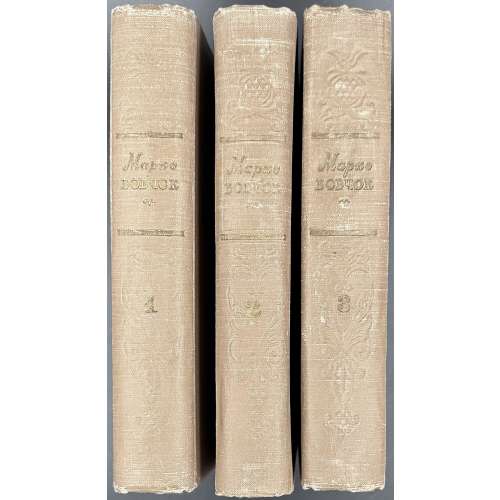 Three 8vo volumes, 20.8 x 13.8 cm each, uniformly bound in brown cloth with gilt lettering and embossed design to front and spine; v. 1: [1-4] 5-537 [3], total 540 pages plus frontispiece, two-colour woodcut portrait, by Ivan Nikolaevtsev; v. 2: [1-6] 7-537 [3], total 540 pages; v. 3: [1-6] 7-620 [4], total 624 pages. Waterstain throughout the third volume. Title-page (red and black): Марко Вовчок | СОБРАНИЕ СОЧИНЕНИЙ | ТОМ ПЕРВЫЙ (ВТОРОЙ, ТРЕТИЙ) | {fleuron} | ИЗДАТЕЛЬСТВО «ИЗВЕСТИЯ» | Москва | 1957 || Opposite t.p. (red and black): Марко Вовчок | СОБРАНИЕ СОЧИНЕНИЙ | В ТРЕХ | ТОМАХ | {fleuron} | ИЗДАТЕЛЬСТВО «ИЗВЕСТИЯ» | Москва | 1957 || Half-title (red and black): БИБЛИОТЕКА КЛАССИКОВ | ЛИТЕРАТУР | НАРОДОВ СССР | | {fleuron} || Imprint: Вступительная статья А. Белецкого. Подготовка текста и примечания С. Машинского. Print run: 30,000 copies. Contributors: Марко Вовчок [Marko Vovchok; Марія Олександрівна Вілінська] (Ukrainian, 1833 – 1907) – author. Other variants: Markowovzok and Marko Vovtchok. Олександр Іванович Білецький [Александр Иванович Белецкий] (Ukrainian, 1884 – 1961) – author/preface. Семен Иосифович Машинский (Ukrainian, 1914-1978) – author/editing and comments. Иван Григорьевич Николаевцев (Ukrainian, 1902–1960) – artist.
Three 8vo volumes, 20.8 x 13.8 cm each, uniformly bound in brown cloth with gilt lettering and embossed design to front and spine; v. 1: [1-4] 5-537 [3], total 540 pages plus frontispiece, two-colour woodcut portrait, by Ivan Nikolaevtsev; v. 2: [1-6] 7-537 [3], total 540 pages; v. 3: [1-6] 7-620 [4], total 624 pages. Waterstain throughout the third volume. Title-page (red and black): Марко Вовчок | СОБРАНИЕ СОЧИНЕНИЙ | ТОМ ПЕРВЫЙ (ВТОРОЙ, ТРЕТИЙ) | {fleuron} | ИЗДАТЕЛЬСТВО «ИЗВЕСТИЯ» | Москва | 1957 || Opposite t.p. (red and black): Марко Вовчок | СОБРАНИЕ СОЧИНЕНИЙ | В ТРЕХ | ТОМАХ | {fleuron} | ИЗДАТЕЛЬСТВО «ИЗВЕСТИЯ» | Москва | 1957 || Half-title (red and black): БИБЛИОТЕКА КЛАССИКОВ | ЛИТЕРАТУР | НАРОДОВ СССР | | {fleuron} || Imprint: Вступительная статья А. Белецкого. Подготовка текста и примечания С. Машинского. Print run: 30,000 copies. Contributors: Марко Вовчок [Marko Vovchok; Марія Олександрівна Вілінська] (Ukrainian, 1833 – 1907) – author. Other variants: Markowovzok and Marko Vovtchok. Олександр Іванович Білецький [Александр Иванович Белецкий] (Ukrainian, 1884 – 1961) – author/preface. Семен Иосифович Машинский (Ukrainian, 1914-1978) – author/editing and comments. Иван Григорьевич Николаевцев (Ukrainian, 1902–1960) – artist. -
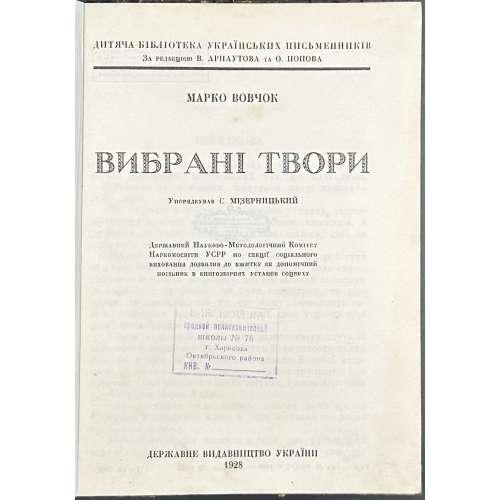 Owner’s quarter cloth over faux marbled paper binding, 19.8 x 15.1 cm, pp.: [1-4] 5-227 [3], total 230 pages plus frontispiece (b/w photographic portrait w/facsimile); library blue ink stamp to t.p. “Библиотека средней политехнической школы № 76 г. Харькова Октябрьского района Инв. № ___». Title-page: ДИТЯЧА БIБЛIОТЕКА УКРАЇНСЬКИХ ПИСЬМЕННИКIВ | За редакцiєю В. АРНАУТОВА та О. ПОПОВА | — | ВИБРАНI ТВОРИ | Упорядкував С. МIЗЕРНИЦЬКИЙ | Державний Науково-Методологiчний Комитет | Наркомосвiти УСРР по секциï сицiяльного | виховання дозволив до вжитку як допомiчний | посiбник в книгозбiрнях установ соцвиху | ДЕРЖАВНЕ ВИДАВНИЦТВО УКРАЇНИ | 1928 || Contents: Передмова, Викуп, Паньска воля (Горпина), Козачка, Ледащиця, Чумак, Не до пари, Тюлева баба, Кармелюк, Гайдамаки. Print run: 5,000 copies. Contributors: Марко Вовчок [Marko Vovchok; Марія Олександрівна Вілінська] (Ukrainian, 1833 – 1907) – author. Other variants: Markowovzok and Marko Vovtchok.
Owner’s quarter cloth over faux marbled paper binding, 19.8 x 15.1 cm, pp.: [1-4] 5-227 [3], total 230 pages plus frontispiece (b/w photographic portrait w/facsimile); library blue ink stamp to t.p. “Библиотека средней политехнической школы № 76 г. Харькова Октябрьского района Инв. № ___». Title-page: ДИТЯЧА БIБЛIОТЕКА УКРАЇНСЬКИХ ПИСЬМЕННИКIВ | За редакцiєю В. АРНАУТОВА та О. ПОПОВА | — | ВИБРАНI ТВОРИ | Упорядкував С. МIЗЕРНИЦЬКИЙ | Державний Науково-Методологiчний Комитет | Наркомосвiти УСРР по секциï сицiяльного | виховання дозволив до вжитку як допомiчний | посiбник в книгозбiрнях установ соцвиху | ДЕРЖАВНЕ ВИДАВНИЦТВО УКРАЇНИ | 1928 || Contents: Передмова, Викуп, Паньска воля (Горпина), Козачка, Ледащиця, Чумак, Не до пари, Тюлева баба, Кармелюк, Гайдамаки. Print run: 5,000 copies. Contributors: Марко Вовчок [Marko Vovchok; Марія Олександрівна Вілінська] (Ukrainian, 1833 – 1907) – author. Other variants: Markowovzok and Marko Vovtchok. -
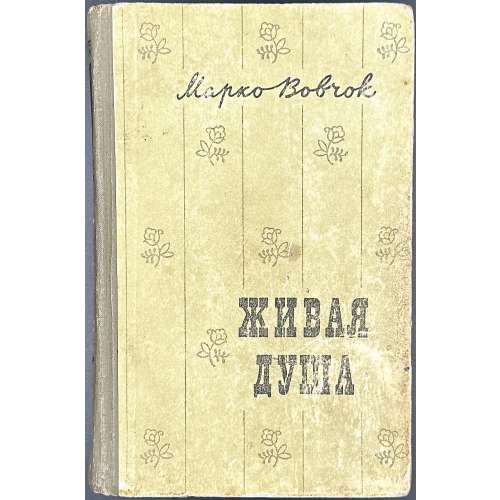 Hardcover volume 20.8 x 13.5 cm, quarter olive cloth over cardboard, diaper design with lettering to front and lettering on black label to spine; pp.: [2] blank/portrait, [1, 2] t.p./imprint, 3-331 [5], total 338 pages, linocut portrait and chapter headpieces by Volkovinskaia. Some pages spotted, about 1/3 of p. 133/134 lost. Re-printed from 6-vol. edition of Vovchok’s collected works, 1956. Title-page: МАРКО ВОВЧОК | ЖИВАЯ | ДУША | РОМАН | ИЗДАТЕЛЬСТВО ЦК ЛКСМУ «МОЛОДЬ» | КИЕВ 1962 || Print run: 50,000 copies. Contributors: Марко Вовчок [Marko Vovchok; Марія Олександрівна Вілінська] (Ukrainian, 1833 – 1907) – author. Other variants: Markowovzok and Marko Vovtchok. Зінаїда Володимирівна Волковинська [Зинаида Владимировна Волковинская; Zinaïda Volkovynsʹka] (Ukrainian, 1915 – 2010) – artist.
Hardcover volume 20.8 x 13.5 cm, quarter olive cloth over cardboard, diaper design with lettering to front and lettering on black label to spine; pp.: [2] blank/portrait, [1, 2] t.p./imprint, 3-331 [5], total 338 pages, linocut portrait and chapter headpieces by Volkovinskaia. Some pages spotted, about 1/3 of p. 133/134 lost. Re-printed from 6-vol. edition of Vovchok’s collected works, 1956. Title-page: МАРКО ВОВЧОК | ЖИВАЯ | ДУША | РОМАН | ИЗДАТЕЛЬСТВО ЦК ЛКСМУ «МОЛОДЬ» | КИЕВ 1962 || Print run: 50,000 copies. Contributors: Марко Вовчок [Marko Vovchok; Марія Олександрівна Вілінська] (Ukrainian, 1833 – 1907) – author. Other variants: Markowovzok and Marko Vovtchok. Зінаїда Володимирівна Волковинська [Зинаида Владимировна Волковинская; Zinaïda Volkovynsʹka] (Ukrainian, 1915 – 2010) – artist. -
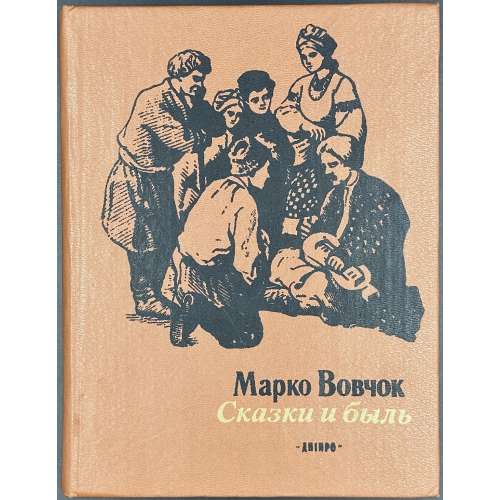 Small volume, 17.2 x 13.2 cm, brown buckram with vignette and lettering to front and spine, pp.: [1-4] 5-315 [5], illustrations: portrait, frontispiece, and two vignettes by I. Gavriliuk; text on Ukrainian and Russian. A reprint of the 1874 edition. Contents: Дев’ять братiв i десята сестриця Галя, Невiльничка, Ведмiдь, Кармелюк, Совершенная курица, Королевна Я, Затейник, Похождения домашнего учителя, Воришка, Чортова пригода. Title-page: Марко Вовчок | Сказки и быль | {vignette} | КИЕВ | ИЗДАТЕЛЬСТВО | ХУДОЖЕСТВЕННОЙ ЛИТЕРАТУРЫ | «ДНIПРО» | 1988 || Print run: 250,000 copies. Contributors: Марко Вовчок [Marko Vovchok; Марія Олександрівна Вілінська] (Ukrainian, 1833 – 1907) – author. Other variants: Markowovzok and Marko Vovtchok. Іван Михайлович Гаврилюк (Иван Михайлович Гаврилюк) (Ukrainian, 1939 – 2008) – artist.
Small volume, 17.2 x 13.2 cm, brown buckram with vignette and lettering to front and spine, pp.: [1-4] 5-315 [5], illustrations: portrait, frontispiece, and two vignettes by I. Gavriliuk; text on Ukrainian and Russian. A reprint of the 1874 edition. Contents: Дев’ять братiв i десята сестриця Галя, Невiльничка, Ведмiдь, Кармелюк, Совершенная курица, Королевна Я, Затейник, Похождения домашнего учителя, Воришка, Чортова пригода. Title-page: Марко Вовчок | Сказки и быль | {vignette} | КИЕВ | ИЗДАТЕЛЬСТВО | ХУДОЖЕСТВЕННОЙ ЛИТЕРАТУРЫ | «ДНIПРО» | 1988 || Print run: 250,000 copies. Contributors: Марко Вовчок [Marko Vovchok; Марія Олександрівна Вілінська] (Ukrainian, 1833 – 1907) – author. Other variants: Markowovzok and Marko Vovtchok. Іван Михайлович Гаврилюк (Иван Михайлович Гаврилюк) (Ukrainian, 1939 – 2008) – artist. -
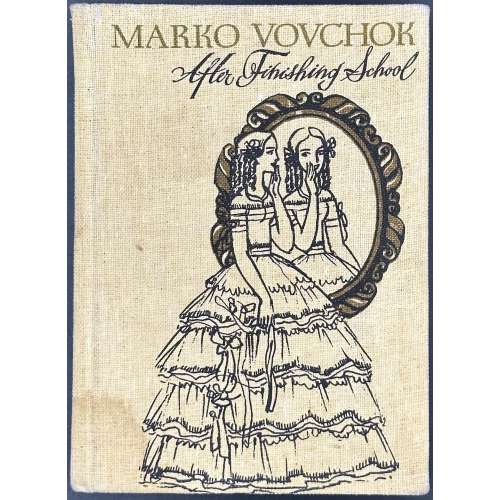 Small volume, 14 x 10 cm, in tan cloth with vignette and lettering to front, lettering to spine, pp.: [1-4] 5-123 [5], total 64 leaves, 10 full-page and 7 double-page two-colour woodcuts within pagination, and numerous b/w in-text vignettes by Serhiy Adamovych; translated from the Ukrainian into English by Oles Kovalenko. Print run: 11,000 copies. Contributors: Марко Вовчок [Marko Vovchok; Марія Олександрівна Вілінська] (Ukrainian, 1833 – 1907) – author. Other variants: Markowovzok and Marko Vovtchok. Олесь Iванович Коваленко (Ukrainian, 1945 – 2012) – translator from the Ukrainian into English. Сергiй Тадейович Адамович [Serhiy Adamovych] (Ukrainian, 1922 – 1998) – artist.
Small volume, 14 x 10 cm, in tan cloth with vignette and lettering to front, lettering to spine, pp.: [1-4] 5-123 [5], total 64 leaves, 10 full-page and 7 double-page two-colour woodcuts within pagination, and numerous b/w in-text vignettes by Serhiy Adamovych; translated from the Ukrainian into English by Oles Kovalenko. Print run: 11,000 copies. Contributors: Марко Вовчок [Marko Vovchok; Марія Олександрівна Вілінська] (Ukrainian, 1833 – 1907) – author. Other variants: Markowovzok and Marko Vovtchok. Олесь Iванович Коваленко (Ukrainian, 1945 – 2012) – translator from the Ukrainian into English. Сергiй Тадейович Адамович [Serhiy Adamovych] (Ukrainian, 1922 – 1998) – artist.


